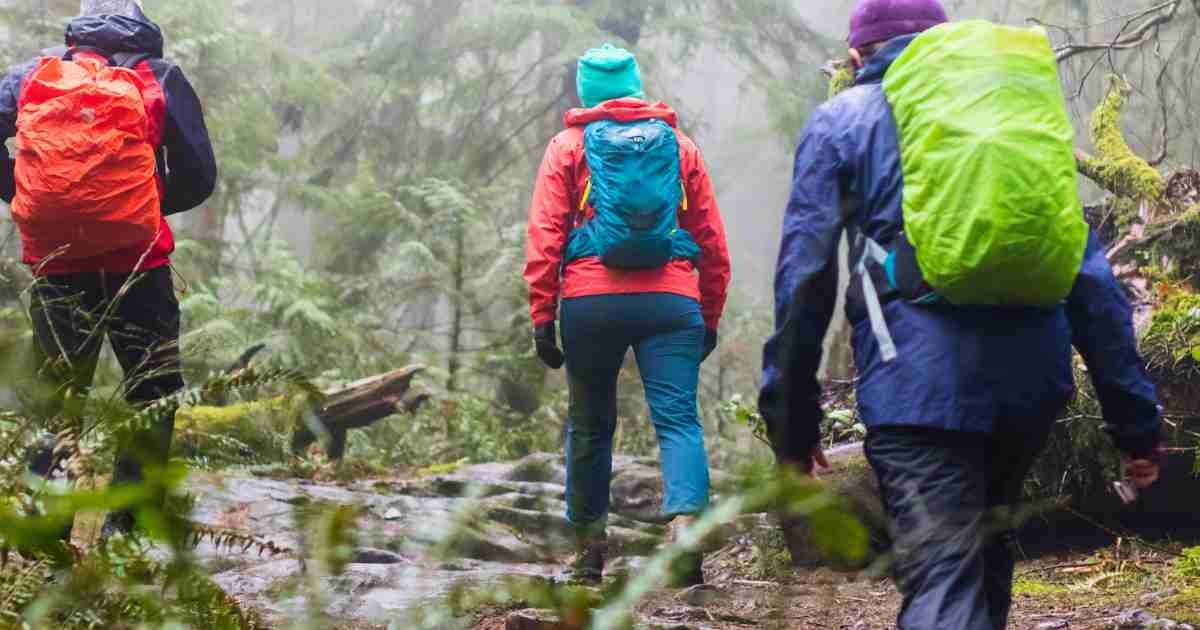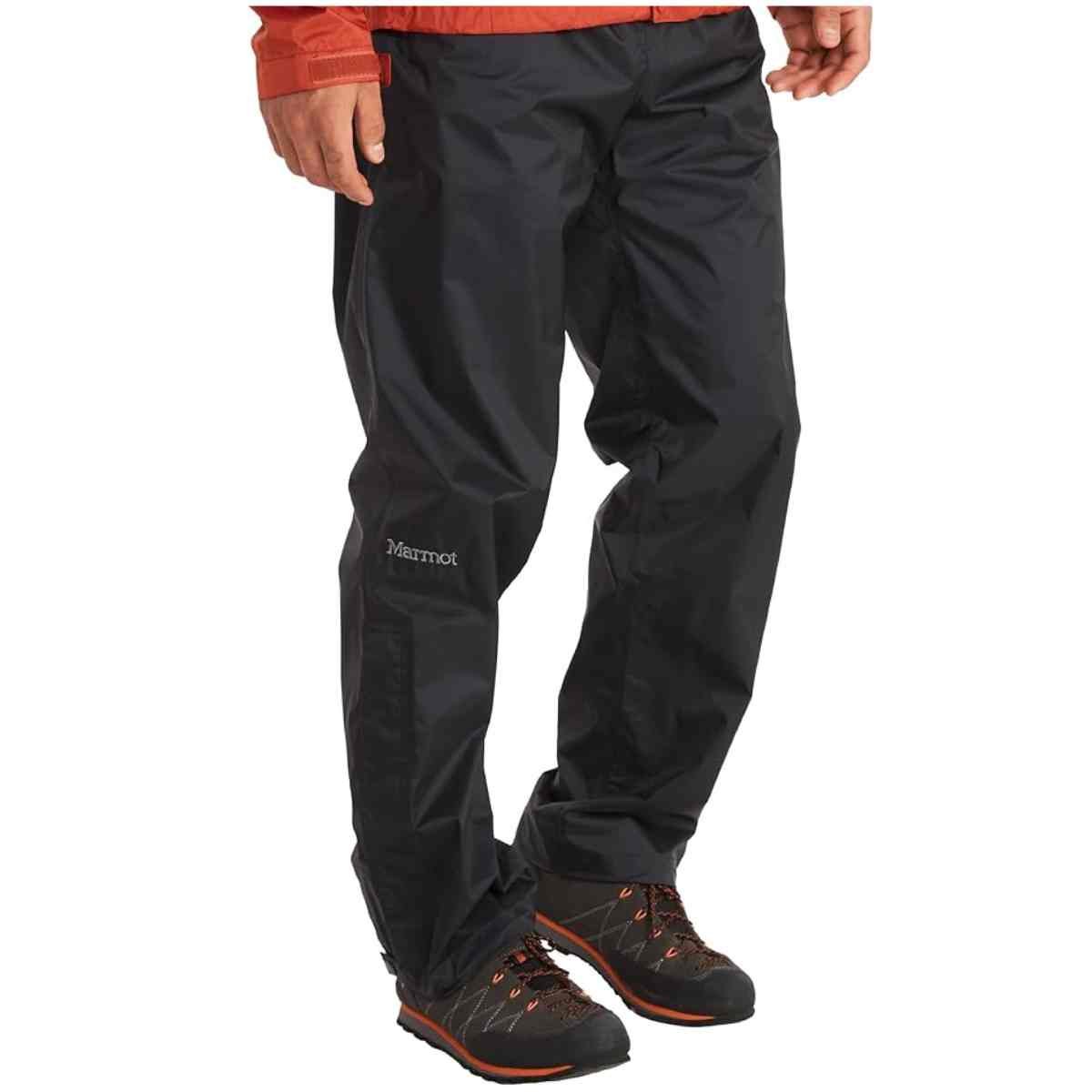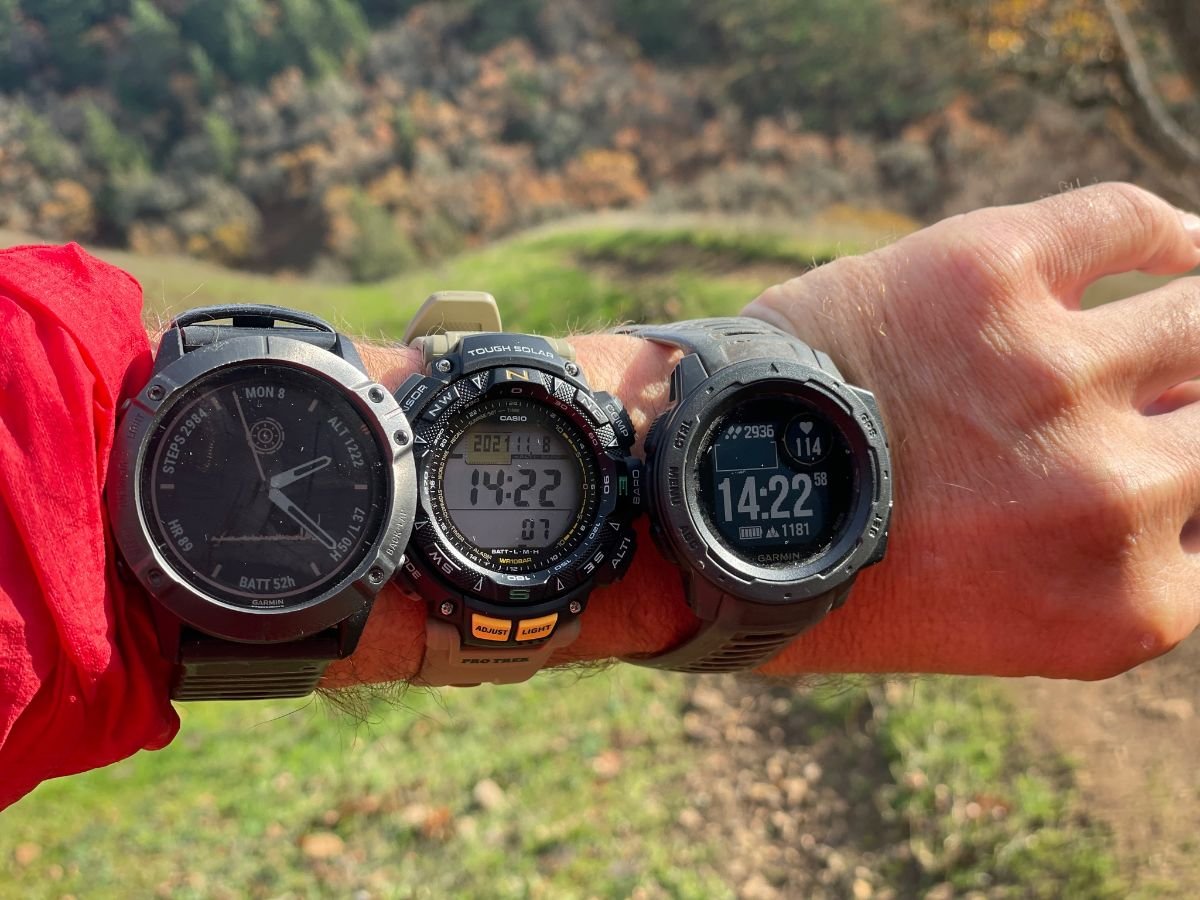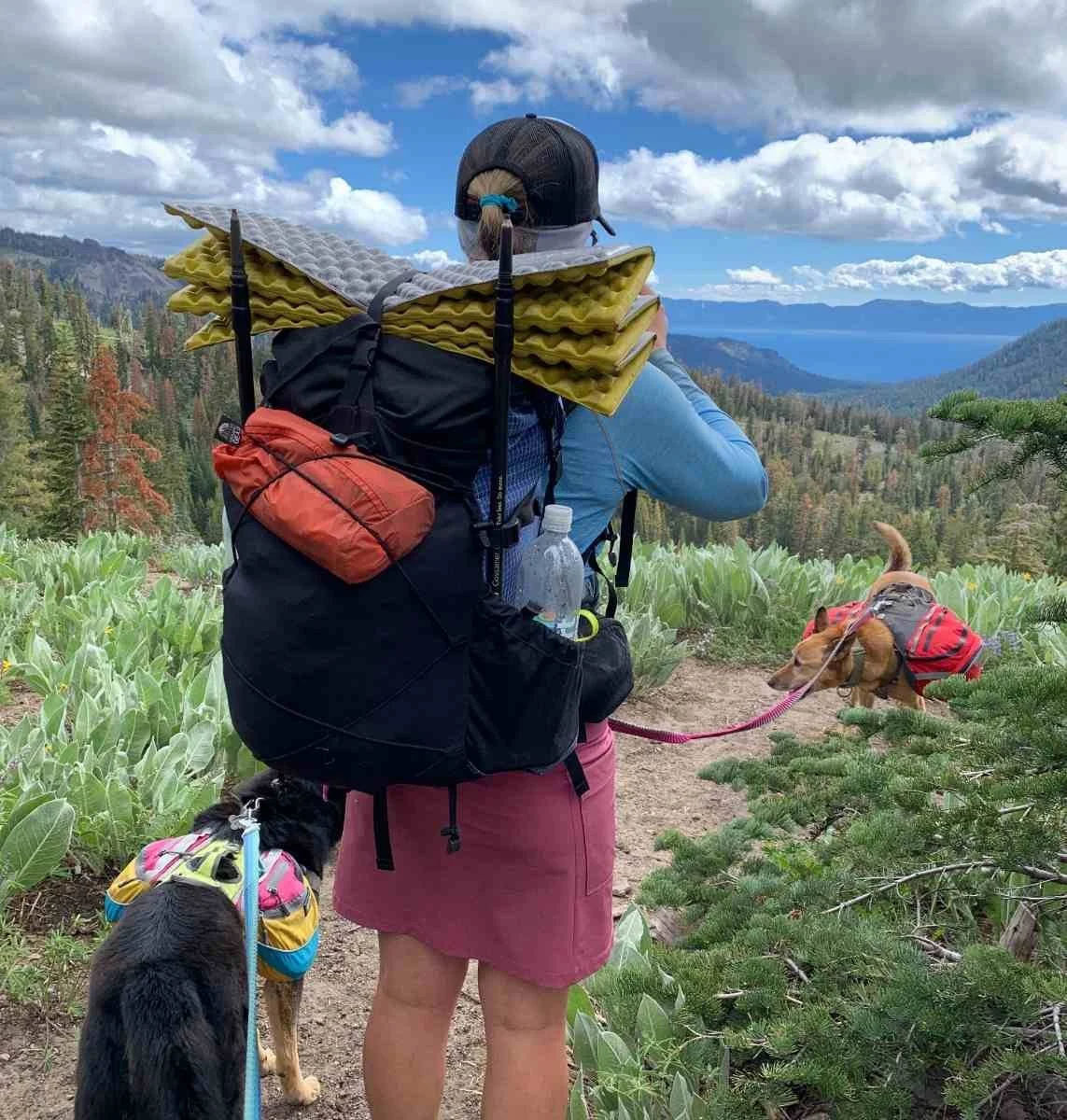Best Rain Pants for Hiking of 2025
stay dry on hikes with comfortable, ventilating, breathable waterproof pants
March 24th, 2025, updated with new info about PFAS in waterproofing and to remove discontinued products
Home > Gear Reviews > Apparel
To find the best hiking rain pants of 2025, I spent more than a year testing rain pants and rain kilts on the journey of their lives.
From warm, summer rain in Uruguay to cold, New York winter rain, to a thru-hike of the Colorado Trail in summer, and thru-hiking the Appalachian Trail in the fall, and then working along the Appalachian Trail in spring, these rain pants saw a lot of different kinds of rain in a lot of different kinds of places.
We tested these rain pants and kilts on short day hikes, long walks in the woods with the dog, almost half a year backpacking, and an unprecedented amount of time in the shower.
We climbed on rocks and eagerly looked forward to the crummiest weather days to go out and stomp in puddles. One pair even came with me on the second half of my thru-hike of the Appalachian Trail and a full thru-hike of the Colorado Trail.
Different types of rain pants are designed with features in mind for different purposes. Some are heavier and thicker, designed for water resistance and durability rather than breathability, while others are super light and designed to be breathable and flexible for hiking. Some perform best in low-intensity outdoor pursuits, others in high-intensity ones.
While testing rain pants, I prioritized comfort while looking for useful and adaptable features. For me, the most important thing in rain gear — aside from actual water resistance — is that they are comfortable and fit well because if they don’t, no amount of handy, beneficial features will make them worth the weight.
However, once fit and comfort are established, features that make them practical such as pockets, packability, and adjustable ankle cuffs or ventilation zippers are ideal! It’s important to decide which of these are essential to you– and whether not having them will be a dealbreaker. Ultimately, the right rain pants for you depend primarily on what sort of rainy activities you’re looking to do, and what features you want from your rain pants.
We looked for the best all-purpose, durable, ultralight, and affordable rain pants as well as the best rain kilt, so you can make an informed decision about what rain pants you’ll bring on your own adventures.
Related: Best Lightweight Rain Jackets
Read More: Best Women’s Rain Boots and Best Men’s Rain Boots
We create reader-supported, objective gear reviews independently selected by our editors. This story may contain affiliate links, which help fund our website. When you click on the links to purchase gear, we may get a commission — without costing you an extra cent. Thank you for supporting our work and mission of outdoor coverage for every body! Learn more.
Hiking rain pants comparison table
| RAIN PANTS | TREELINE AWARD | MSRP* | WEIGHT | WATERPROOFING | PFC / PFAS- FREE | SIZES |
|---|---|---|---|---|---|---|
| Outdoor Research Foray/ Aspire Pants Men's Women's |
Best Overall Read review |
199 | 13.6 oz (men's), 13.2 (women's) | bluesign-approved AscentShell Dry 3L | Yes | S - XXXL (men's), XXS Short - 4X (women's) |
| Marmot PreCip Eco Pants Men's Women's |
Best Affordable Read review |
100 | 8 oz (men's), 7 oz (women's) | NanoPro™ | Yes | S - XXL (men's), XS - XL (women's) |
| Outdoor Research Helium Men's Women's |
Best Ultralight Read review |
130 | 11.3 oz (men's), 10.23 oz (women's) | bluesign® approved Pertex® Shield Diamond Fuse 2.5L | No | XS - XXXL short, regular, tall (men's), XXS - XXL regular, short (women's) |
| Arc'teryx Beta Men's Women's |
Most Durable Read review |
300 | 10.86 (men's), 10.92 oz (women's) | 3-L 80-denier GORE-TEX ePE with C-KNIT backer technology | Yes | XS - XL Tall (men's), 00 short - 16 tall (women's) |
| Zpacks Rain Kilt Unisex |
Best Rain Kilt Read review |
80 | 2.4 oz | Vertice Waterproof Breathable Fabric | No | N/A |
The winners
Best overall hiking rain pants: Outdoor Research Foray II GORE-TEX Pants / Outdoor Research Aspire II GORE-Tex Rain Pants
Sizes: S - XXXL (men's), XXS Short - 4X (women's)
Weight: 13.6 oz (men's), 13.2 (women's)
Waterproof fabric: bluesign-approved AscentShell Dry 3L
Face fabric: 100% Recycled Polyester 50D Plain Weave
PFAS free waterproofing: Yes, for the Spring 2024 model
What we liked: Comfortable, excellent at keeping rain and wind out, have a two-way, three-quarter length ventilation zipper, fit allows full range of motion and ease of movement
What we didn’t like: Non-adjustable ankle cuffs, only one pocket, pants run long
In every situation I wore the Outdoor Research Foray rain pants, they performed exceptionally as an effective barrier against rain and wind, while being very comfortable to wear, easy to move around in, and having adjustable and sufficient ventilation. These may sound like features all rain pants should have, but one pair delivering on all of them was hard to find.
For daily commuting to winter hiking, the Outdoor Research Foray rain pants have just about all the features you’d want and none of the ones you don’t. They’re comfortable to move in, easy to get on and off, roomy enough for layering, and their fabric consistently repels water and shields from wind without feeling stifling — they’re just great all-around rain pants. An ultralight hiker might find these pants too heavy, but for the vast majority of purposes, these pants are a great choice.
Men's (Foray)
Women's (Aspire)
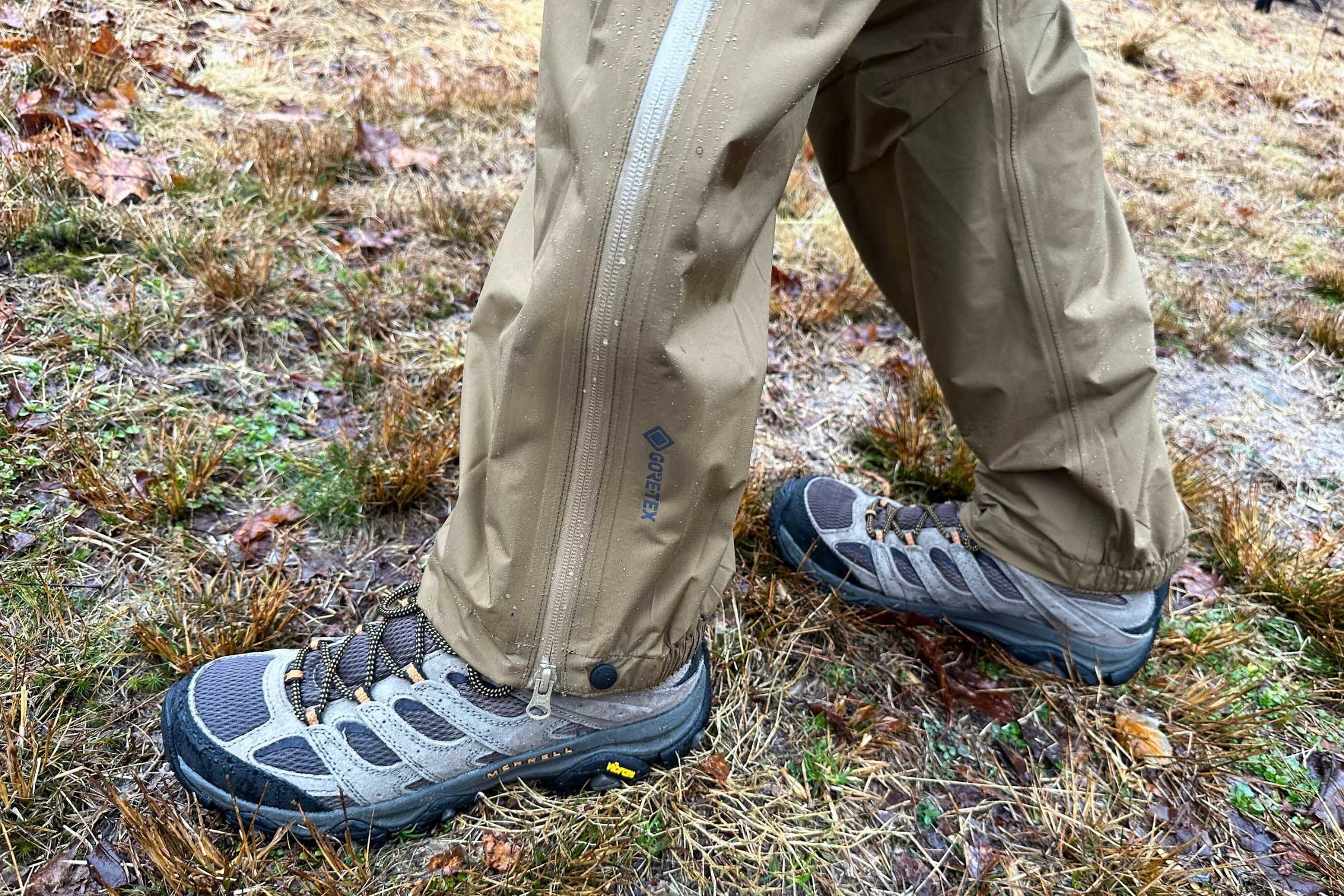
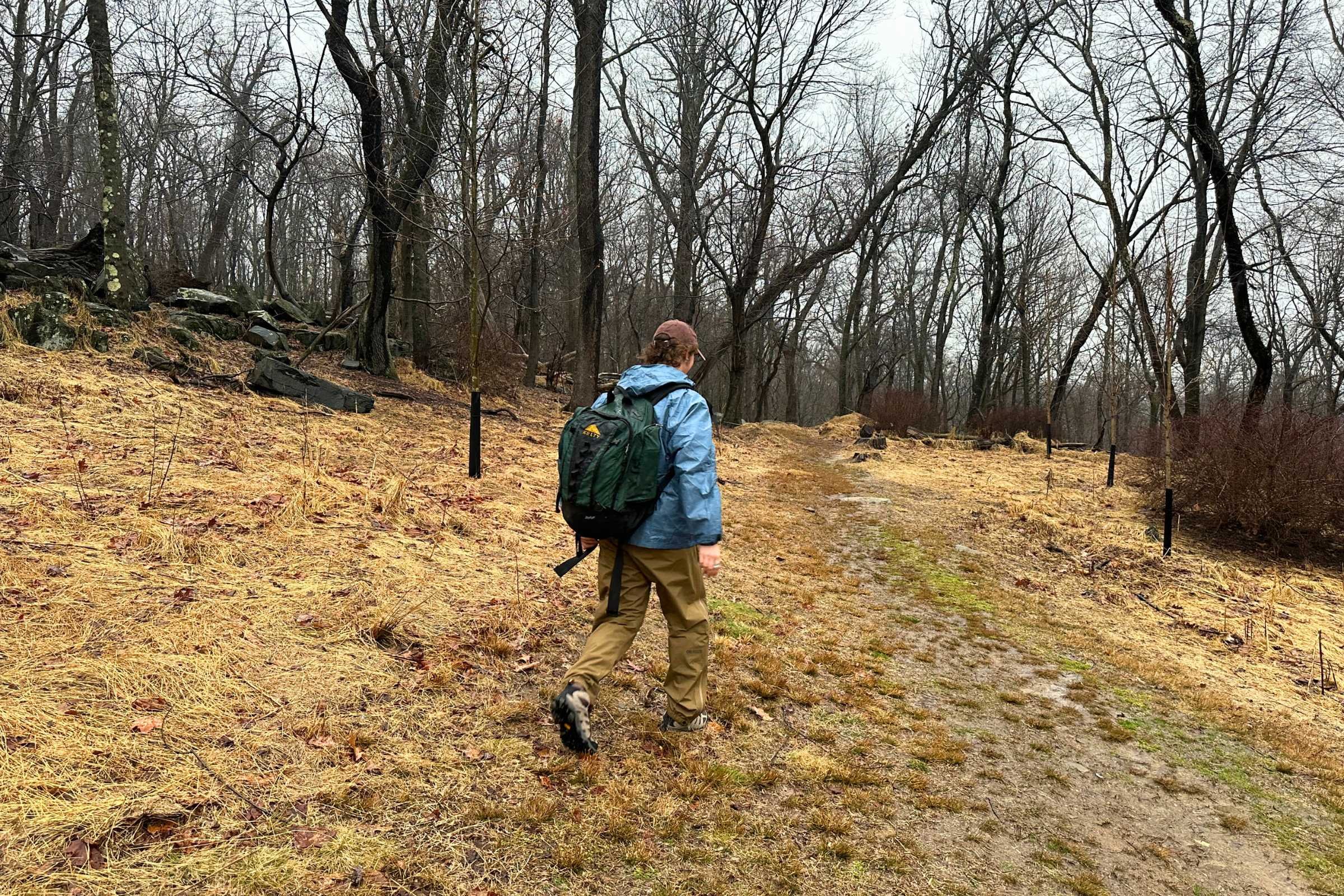


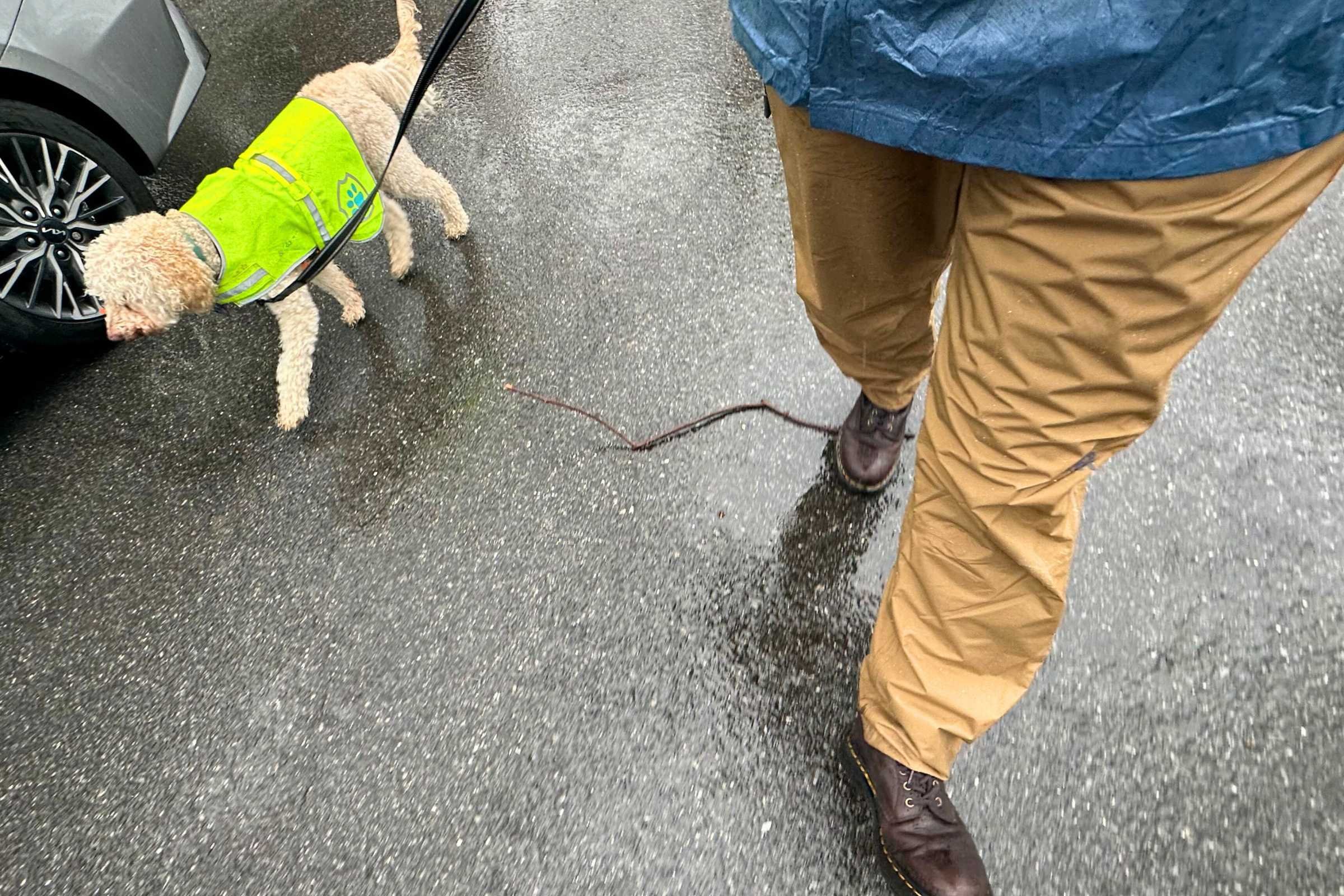
-
A major highlight of the Outdoor Research Foray and women's Aspire rain pants is their two-way ventilation zippers, which go three-quarters of the way up the leg. This is an amazing ventilation feature because it lets you choose the location and length of your upper and lower leg ventilation opening, letting you dump heat easily and effectively whenever you want.
The loose cut of the Foray/Aspire pants coupled with this ankle zipper make them super easy to get on and off, even over boots, which is a must for me. While I was out hiking with these, having that adjustability was great for when the rain tapered off and started back up again, and for easy changing in and out of the pants in the trailhead parking lot.
The Outdoor Research Foray and Aspire pants have elastic but non-adjustable ankle cuffs and a drawstring toggle-adjustable waistband. Significantly, the toggle doesn’t dig when worn with a hip belt and the drawstring doesn’t impede the comfort of the waistband. It’s also easy to adjust while out and moving, which is a perk.
-
Though the Foray and Aspire rain pants have only one pocket, it’s a sufficiently large and zippered back pocket, with more than enough room for a phone, wallet, set of keys, and even a small set of binoculars. It also has a storm flap over the zipper, which effectively stops water from leaking into the pocket under sustained precipitation.
Also, the pocket doubles as a stuff sack for the pants when not in use — they pack down into it easily and have a loop for easy attachment to a pack. I love a good built-in, well-contained, useful storage option with an attachment point, so this feature levels up these pants for me.
Front pockets would have been a nice touch, but the one rear pocket is sufficiently spacious and zips shut. Plus, it doubles as a stuff sack when these pants are not in use.
-
On top of the useful features, the Foray and Aspire rain pants feel sturdy without being overly heavy, and are light enough to take backpacking while still effectively sealing out water and wind. The fabric isn’t nearly as crinkly as some of the other ones tested, including the Patagonia Torrentshell.
For just about every outdoor pursuit or general-purpose use, having non-annoying fabric is a must, and the Foray pants outperformed every other pair they were up against. Even when I wore them for several hours at a time, they didn’t feel stifling or clammy with perspiration. They were comfortable enough to wear almost all day during a persistently rainy day. I barely even noticed them on — they were the only pants I can truly say this about.
-
The Foray and Aspire rain pants do have a couple of drawbacks that were ultimately not dealbreakers. The first is that they run really long. I noticed, and customer reviewers noticed. It’s unfortunate. While they come in multiple lengths, this pair’s inseam is longer than advertised — the regular length inseam is claimed to be 32 inches, but these are a little under two and a half inches longer than other pants I own with the same claimed inseam.
On a semi-related note, I love when ankle cuffs are not just elastic but also adjustable (like the top-tier ankle cuffs of the Marmot PreCips), and these are sadly just elastic. Given that these pants do run long, adjustable ankle cuffs would have been a nice touch and mitigated the bulk of the length issue. When you’re wearing shoes or boots with a thicker sole or heel, this isn’t as problematic, but without them the fabric comes down past the heels and it’s easy to trip over. I noticed this when I was walking to the grocery store in tennis shoes — while not a problem in my hiking boots, the excess length was noticeable without them.
-
The Outdoor Research Foray II and Aspire II are now Outdoor Research's most eco-friendly waterproof products and as free of added PFAS/PFCs.
However, as of publication, there's still a lot of last year's Foray and Apsires at retailers. If you're concerned about PFAS, be sure to check which model you are getting.
Outdoor Research is currently moving away from PFAS/PFCS in their waterproofing technology and has begun to release other rain gear with eco-friendly waterproofing technology like their more-entry level Stratoburst rain pants (women's and men's). For more information, see their blog post on PFAS.
-
For nearly every purpose, the Outdoor Research Foray pants are my top choice. They effectively block out wind and rain, aren’t overly heavy, and don’t crinkle or restrict movement, even if they’re a bit long. If you’re looking for relatively lightweight, sturdy rain pants that can handle just about every rainy or windy situation you’ll find yourself in, these are a great pick.
Best affordable hiking rain pants: Marmot PreCip Eco Pants
Sizes: S - XXL (men's), XS - XL (women's)
Weight: 8 oz (men's), 7 oz (women's)
Waterproof fabric: NanoPro
PFAS free waterproofing: Yes, PFC-free recycled nylon
Face fabric: 100% Pre-Consumer Recycled Nylon, Ripstop
What we liked: Roomy fit is easy to move in, has adjustable ankle cuffs and zippered pockets
What we didn’t like: Clammy in warm or humid weather
I was excited to test these pants because I’d seen a few people satisfied with them on my Appalachian Trail thru-hike, and was pleased to find that they did not disappoint. After the Outdoor Research Foray pants (read review above), the Marmot Precips were my second favorite rain pants to test and the ones I’d be most likely to take on another thru-hike if I were going to be out in late fall or winter.
Even though they’re a couple of ounces heavier than the lightest possible option, the additional features they boast — like their adjustable ankle cuffs, non-digging elastic waistband, and multiple roomy zippered pockets — make them well worth the weight.
The adjustable ankle cuffs made it easy to seal the gap between my legs and the pants, enabling me to stomp in the deepest possible puddles without getting the cuffs of my non-rain pants wet.
View the Marmot PreCip Eco Pants
Men's
Women's
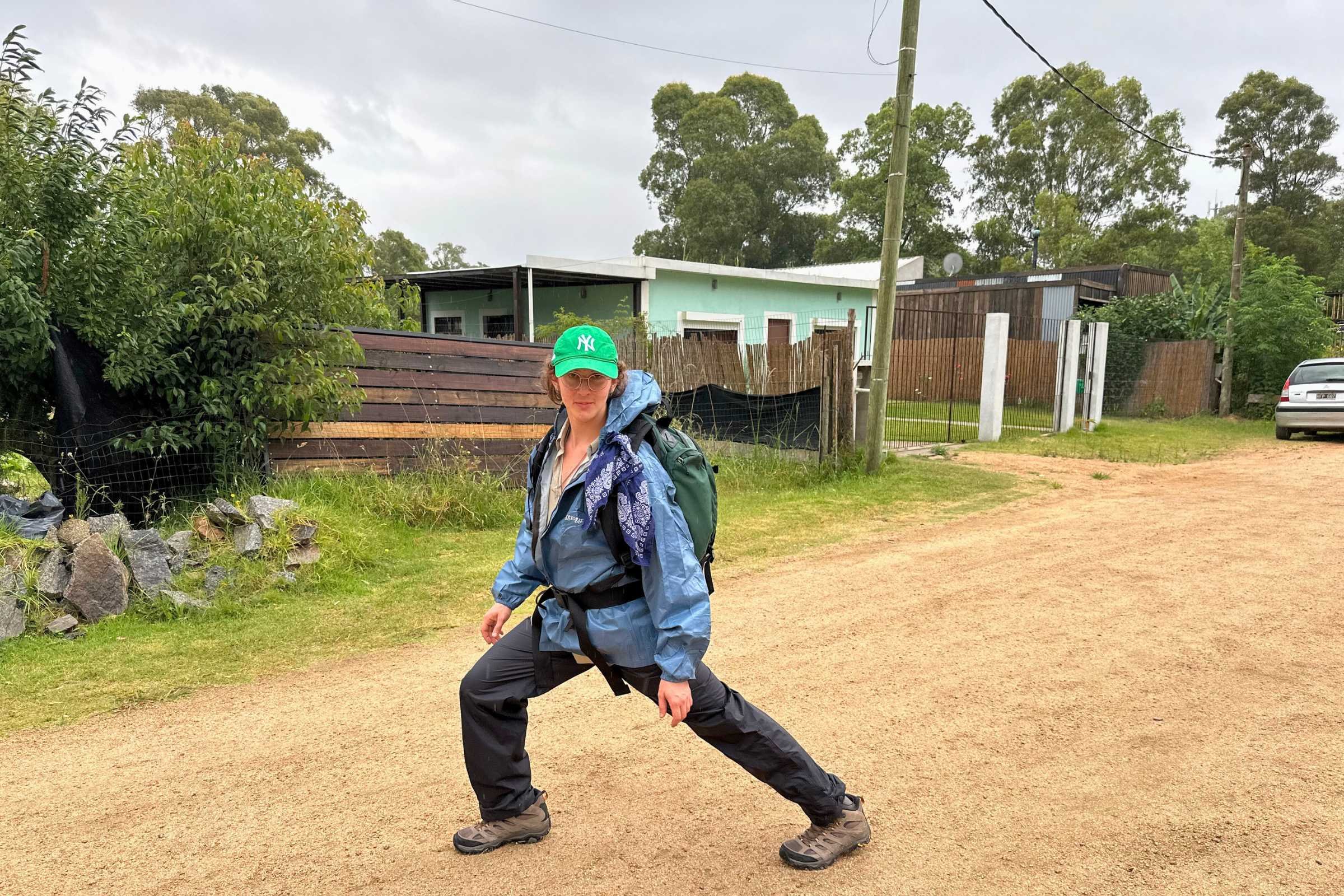
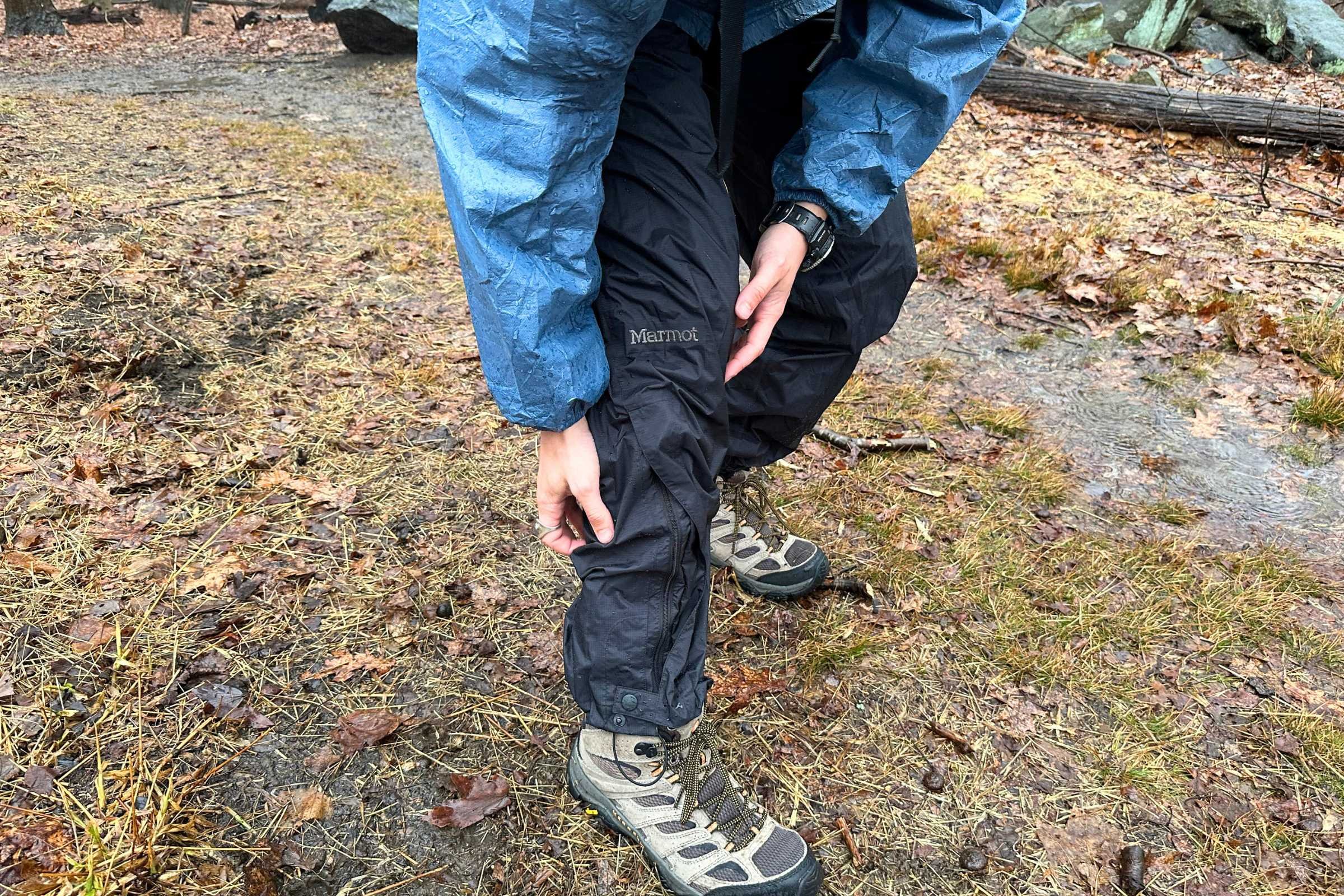
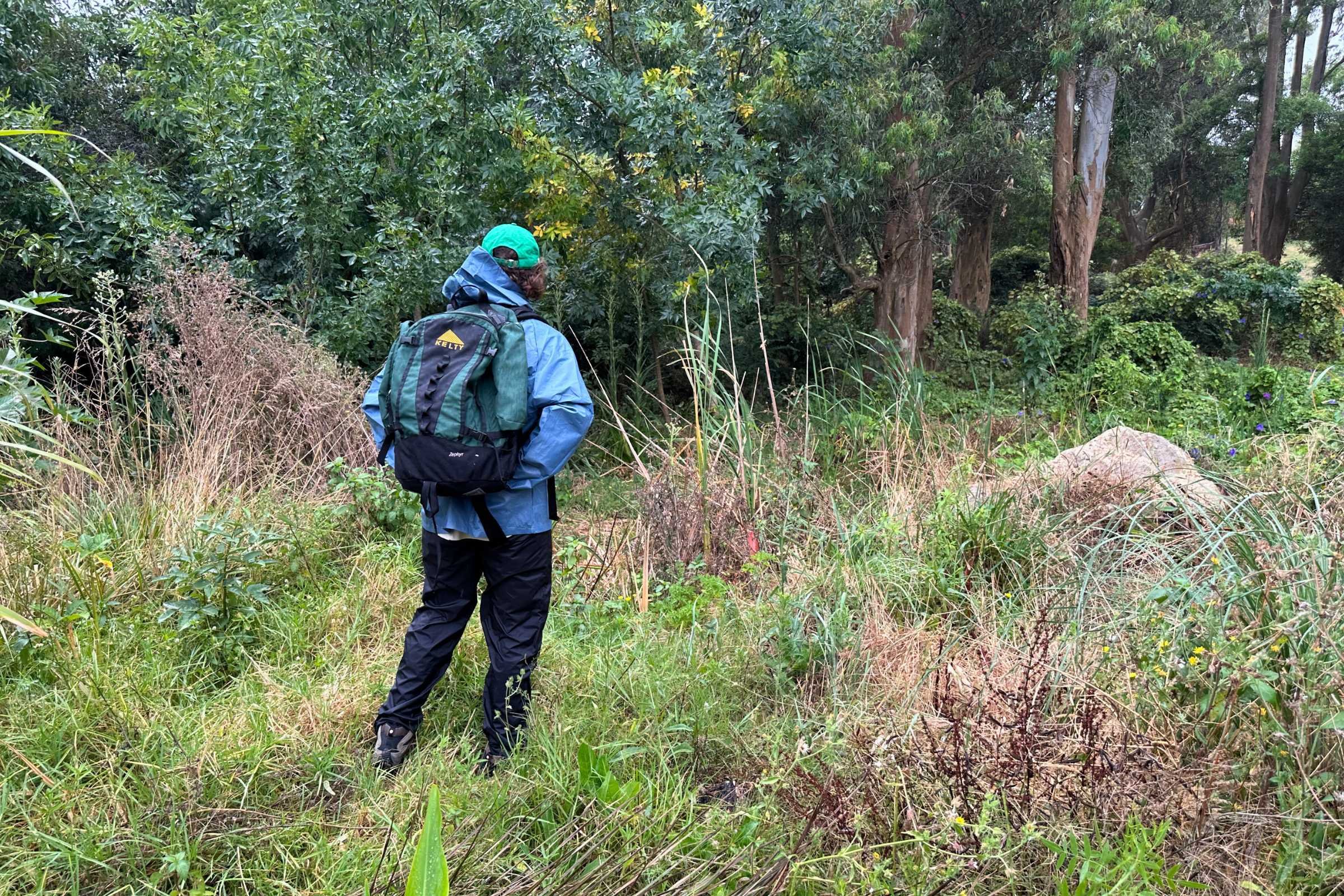
-
The fabric is breathable without being overly thin or flimsy. It took these pants a long time to wet out in heavy rain. At the end of a long walk in 40º temperatures, I felt no clamminess in these pants, but while hiking in high 50ºs and low 60ºs temperatures I felt some moisture begin to build up. Nonetheless, they dried quickly. Within half an hour of being hung up in a warm room, they were almost completely dry.
-
I especially appreciate that the Marmot PreCip pants have such ample pockets. Each of the two zippered side pockets have enough room for a phone, wallet, keys, and earbuds, and the zippered back pocket has enough room for all of that except the phone. (To be fair to the still-quite-roomy back pocket of these pants, my iPhone 14 has a very thick case, a phone stand, and a wallet attached to it.)
If your phone isn’t as adorned, it just might fit in the back pocket. And regardless of any minor pocket sizing qualms, these pants have multiple pockets– sides and back– to choose from, which was a nice touch. And nicer still, I found that the storm flaps on the back and side pockets effectively keep water out over several hours of precipitation. Plus, the pants pack down into the back pocket when not in use!
-
The waistband and fabric on the Marmot PreCip Eco Pants are both more comfortable than the similar caliber REI Trailmade pants. The one reason the PreCips didn’t win the overall best rain pants category is because, after about two hours of sustained rain, they feel clammier than the Foray rain pants. The fabric has a more crinkly texture overall than the Foray as well. But for hiking and general purposes like walking, biking, or commuting, these would also be a good pick, especially if the aforementioned features are important to you.
-
The fit of these pants is standard and true to size — they are roomy enough for reasonable layering to be simple, and the cut allows for more of a full range of motion than the Outdoor Research Helium or REI Trailmade pants. Their roomier cut coupled with the ankle zippers made them very easy to get on and off over my sneakers and trail runners, and only mildly inconvenient to get on and off over Merrell Moab boots.
-
They are ideal for multi-season use as they provide sufficient coverage in freezing rain and wind. They are also light enough — while taking advantage of the ventilation options — to wear hiking in warm summer rain without overheating. And they’re free from PFCs and PFAS, so their waterproofing not only performs excellently but is a fantastic, environmentally-conscious choice!
Best ultralight hiking rain pants: Outdoor Research Helium Rain Pants
Sizes: XS - XXXL short, regular, tall (men's)
XXS - XXL regular, short (women's)
Weight: 11.3 oz (men's), 10.23 oz (women's)
Waterproof fabric: bluesign® approved Pertex® Shield Diamond Fuse 2.5L
PFAS free waterproofing: No
Face fabric: bluesign® approved 100% Nylon, 30D Ripstop
What we liked: Exceptionally lightweight and breathable, great for light rain in warm weather
What we didn’t like: Cut is a bit too slim, which makes it difficult to get them on and off over boots
The Helium Rain Pants by Outdoor Research are extremely lightweight rain pants that win our award for best ultralight rain pants. I would recommend these for a 3-season thru-hike if I were committed to ultralight rain pants instead of a kilt, as they pack down to the size of three king-sized Snickers bars and are super light. They are also the most breathable option of all the rain pants tested in addition to being the lightest, so if breathability is a big priority then these pants are an ideal choice. And while quite breathable, they are still quite effective at blocking moderate wind and rain– though in cold winter gusts, they let in a bit more wind than was comfortable.
Compare prices of the Outdoor Research Helium Rain Pants
Men's
Women's
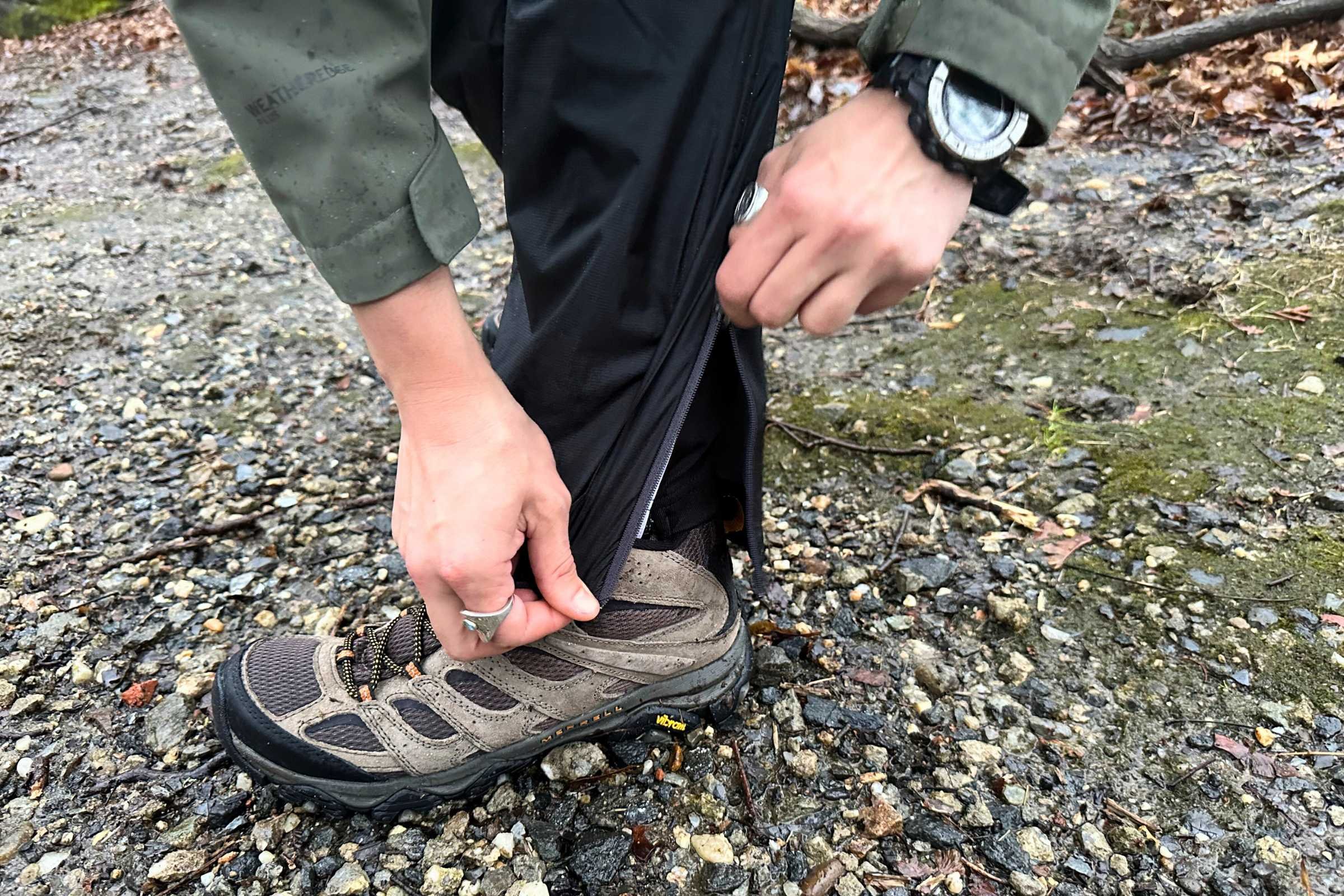
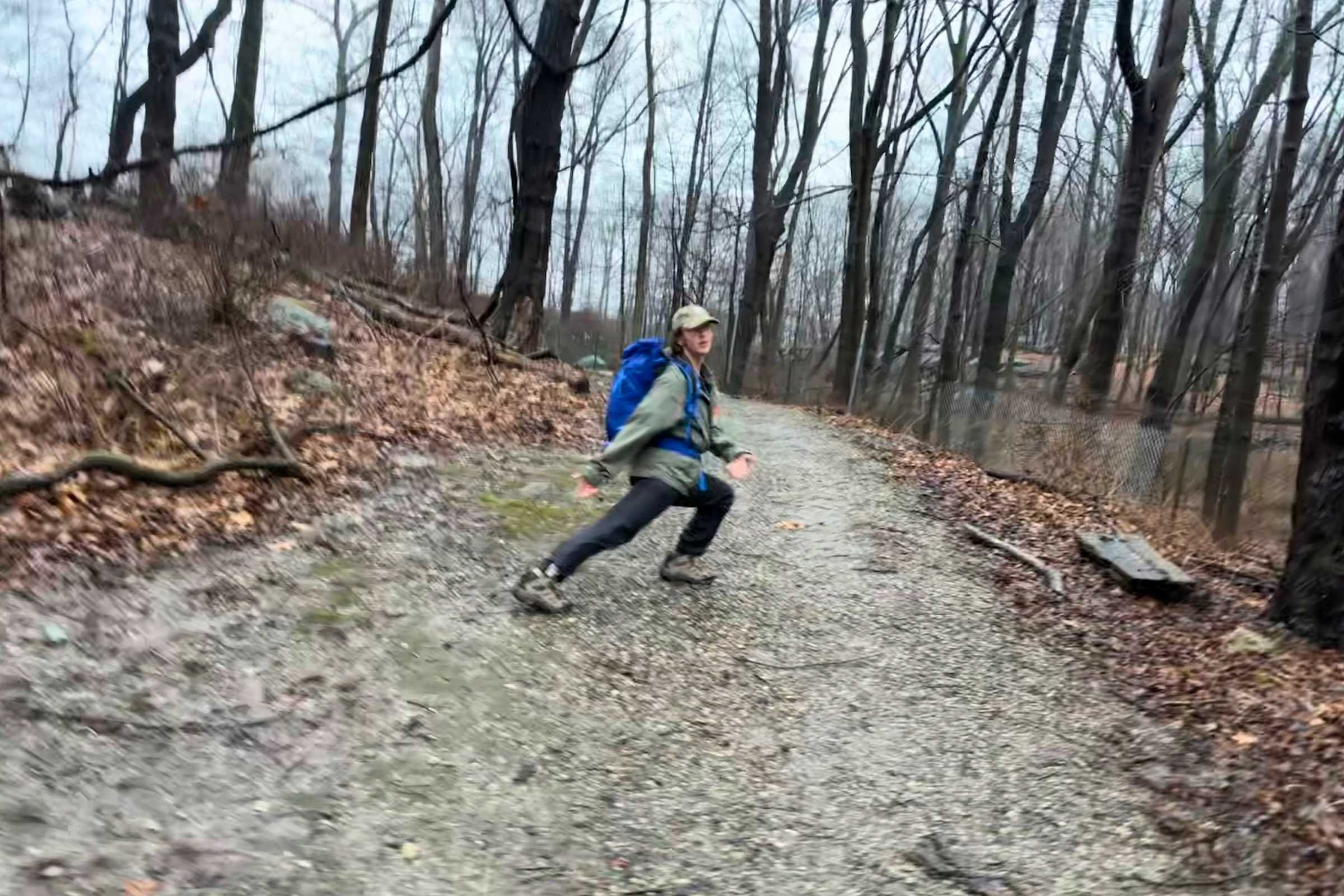
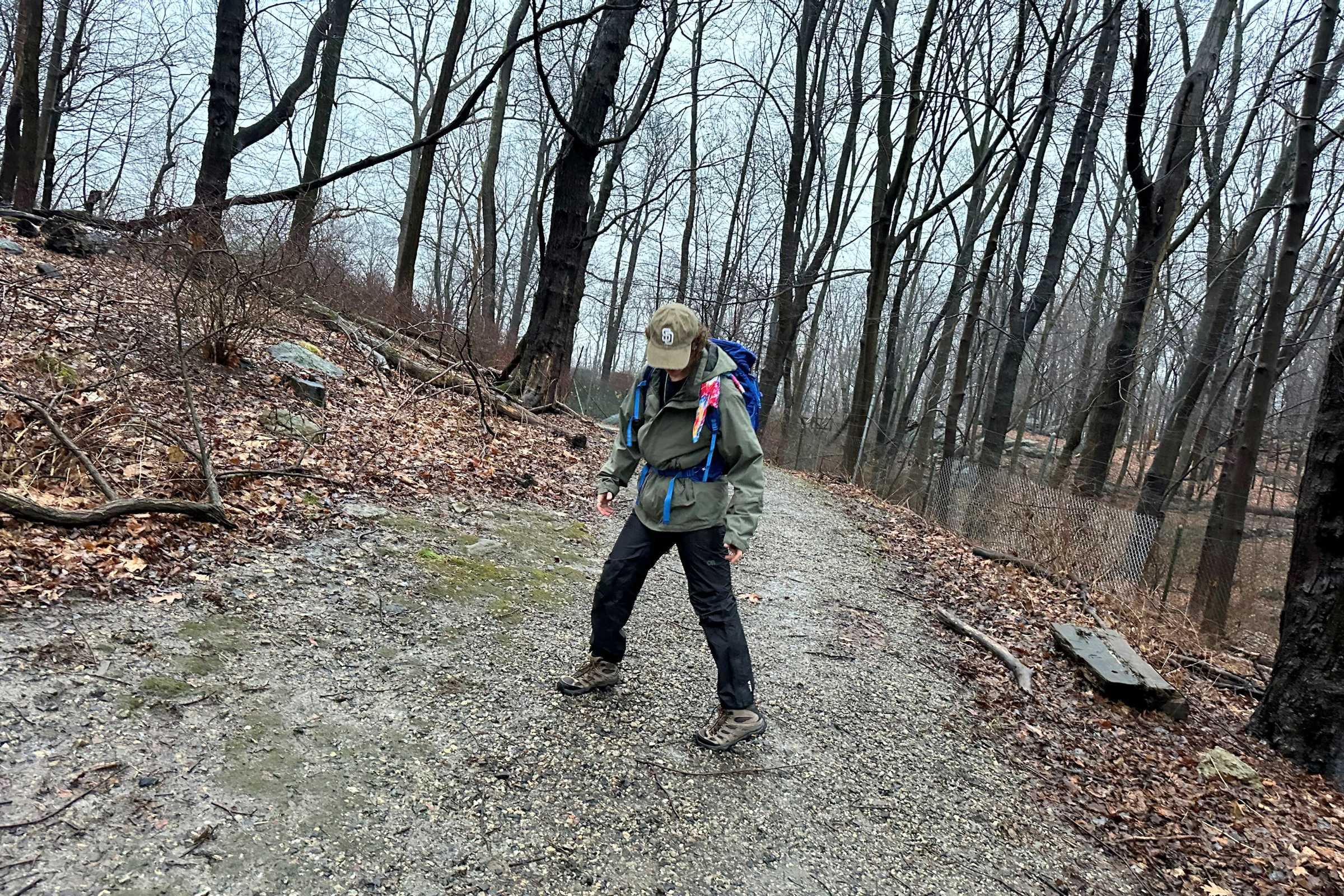
-
The pants have a slim cut and the ankle cuffs are narrow, which is beneficial for keeping some water from splashing up into the pants when stomping in especially deep puddles. It would be nice if these were adjustable, though. Some water still does get in if you’re moving through any substantial puddling, and adjustable ankle cuffs would allow you to close the gap between the pants and your legs. This isn’t a dealbreaker, as the cuffs are still elastic. Not much water tends to enter while you’re hiking unless you’re deliberately stomping in deep puddles, which I did frequently as part of my testing.
I personally did not love the slimmer cut of these pants. I found that as I stepped forward into a lunge, they tightened in the thigh region and restricted the movement. It was only an issue at the end of the movement, but if you have long strides or lift your knees while going uphill, this will likely affect you. I noticed it especially on steeper, New England style trails with scrambling, but this would likely not be an issue on gradually ascending trails.
Also due to the slimmer fit, it’s difficult to layer anything more than tighter base layers underneath. I would recommend sizing up if your usual hiking clothes have any bulk to them– even my Patagonia Baggies were pushing it roominess-wise. Ultimately, this is not a dealbreaker — they were only slightly restrictive, and only when actively stretching —but it is something to be aware of.
-
The Helium rain pants feature an adjustable waistband, elastic but non-adjustable ankle cuffs, and ankle ventilation zippers that reach almost to the knee. The length of these zippers is enough to make them easy to get on over Altra trail runners and Adidas tennis shoes, but it was still a bit of a hassle to get them on over my Merrell Moabs.
While they only have one pocket, it is sufficiently spacious for my giant phone, wallet, and earbuds with room to spare. The pockets' zippers shut underneath a storm flap that helps keep water out. As I love a good built-in storage option, one feature of the Helium rain pants that I appreciate is that they pack down super small into their back pocket, which zips shut and has a loop for easy attachment to a pack.
-
The Helium pants are not yet PFAS-free, but Outdoor Research has released rain gear with eco-friendly waterproofing technology. For more information, see their blog post on PFAS.
-
For the same reason that they’re the lightest and most breathable, the Helium rain pants perform best in warmer temperatures and not quite as well in cooler ones. When I wore them on a hike around 60ºF, they performed well in the sporadic heavy rain and were breathable enough to not make me overheat while still keeping water out. But on a hike in the 40ºs, it quickly became clear that it was too chilly with both the precipitation and strong breeze. So in cooler temperatures, especially with gusty or sustained wind, these would not keep you warm enough without layering underneath.
In steady rain, they soak through after about an hour. I would not use them for winter or colder fall hiking– but if you’re looking for ultralight hiking rain pants that perform well in spring or summer rain, these would be perfect.
Best durable rain pants: Arc’Teryx Beta AR Rain Pants
Sizes: XS - XL Tall (men's), 00 short - 16 tall (women's)
Weight: 10.86 (men's), 10.92 oz (women's)
Waterproof fabric: 3-liter 80-denier GORE-TEX ePE with C-KNIT backer technology
PFAS free waterproofing: Yes– uses FC0 durable water repellent (DWR)
Face fabric: 3-L 80-denier GORE-TEX ePE with C-KNIT backer technology
What we liked: Comfortable, easy to move in, extensive well-designed features, Fair Trade Sewn certified, short, long, and regular lengths
What we didn’t like: Expensive
The Arc’Teryx Beta Rain Pants are unquestionably the most durable of the rain pants we tested. If you’re looking for rain pants that can hold up against heavy, sustained rain, in cooler weather, or outdoors adventures in rougher terrain, these will more than suffice.
They’re durable, well-constructed, allow for full range of motion, and have a variety of well-designed features that make them adaptable for any number of outdoor pursuits. They are made of top-of-the-line PFAS-free GORE-TEX ePE with a recycled face found in the Arc'teryx Beta Rain Jacket, that impressed our reviewers over 3,000 miles of bikepacking the Canadian and U.S. Rocky Mountains.
The Arc'Teryx Beta rain pants cost more than other rain pants we tested, but unlike other pants we tested, have the potential to last ten years.
While we only have a year in these relatively recently released pants, reviews and word of mouth testify to their longevity, so if you want rain pants that can perform in just about any tough conditions, look no further.
Compare prices of the Arc’teryx Beta AR Rain Pants
Men's
Women's
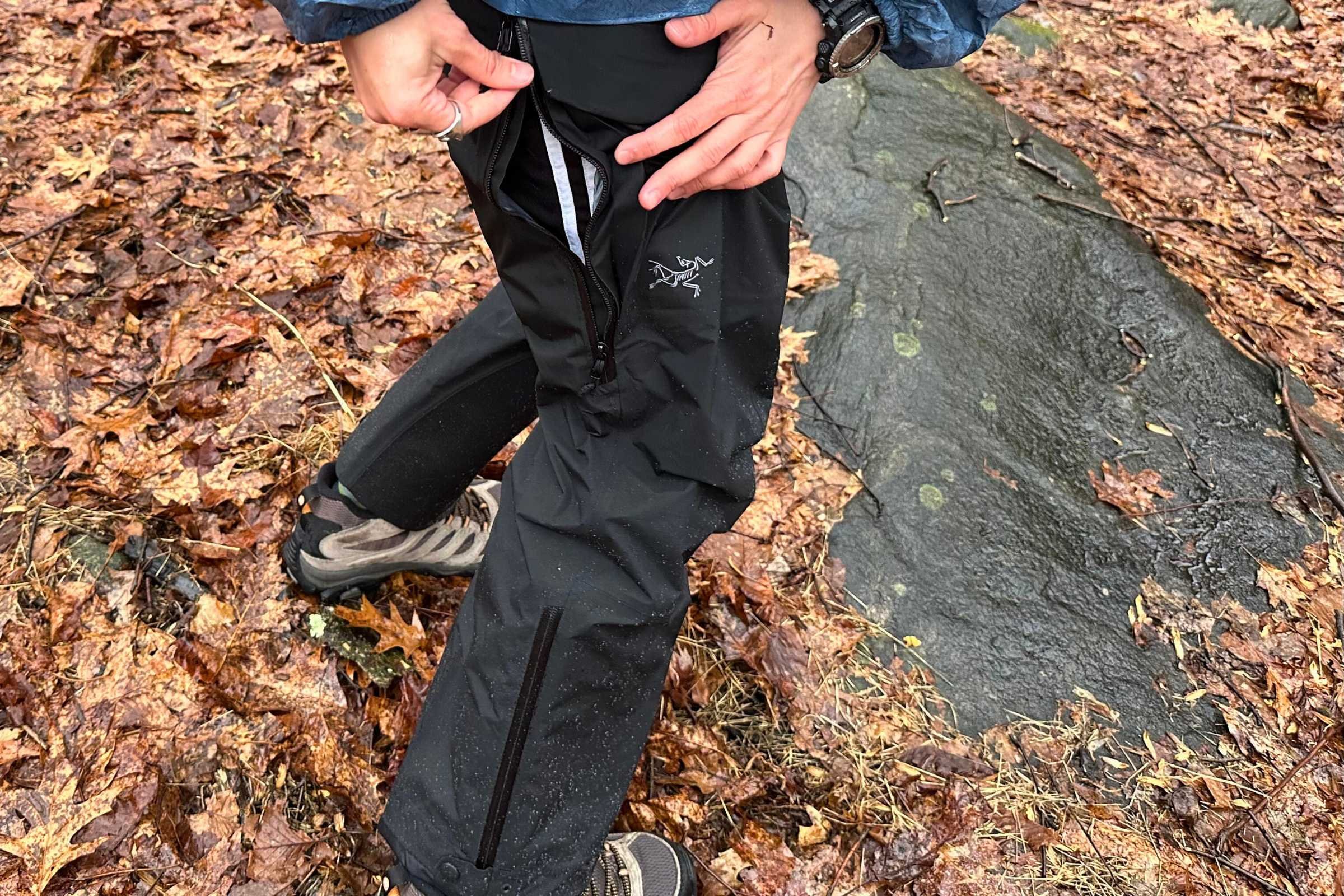

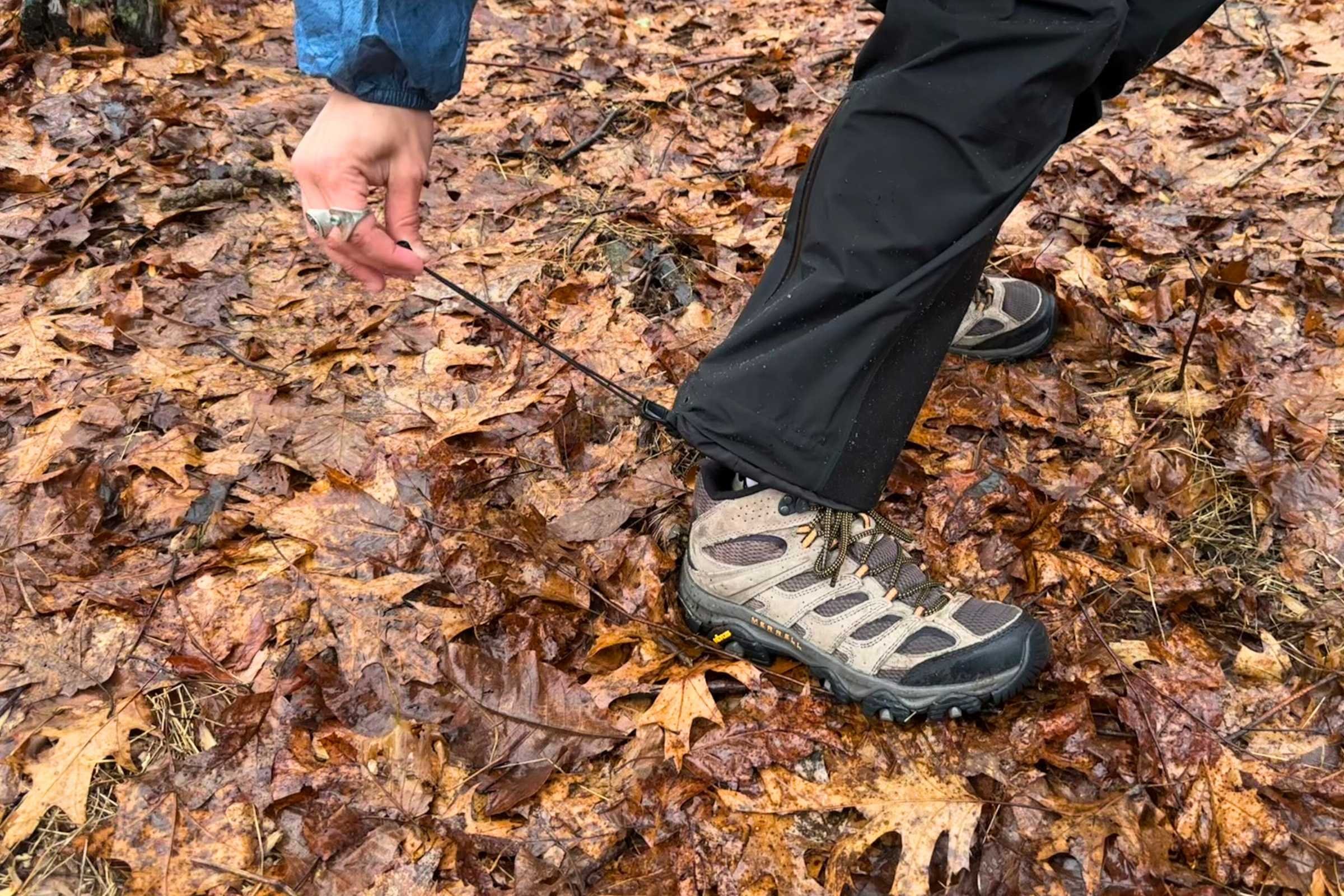
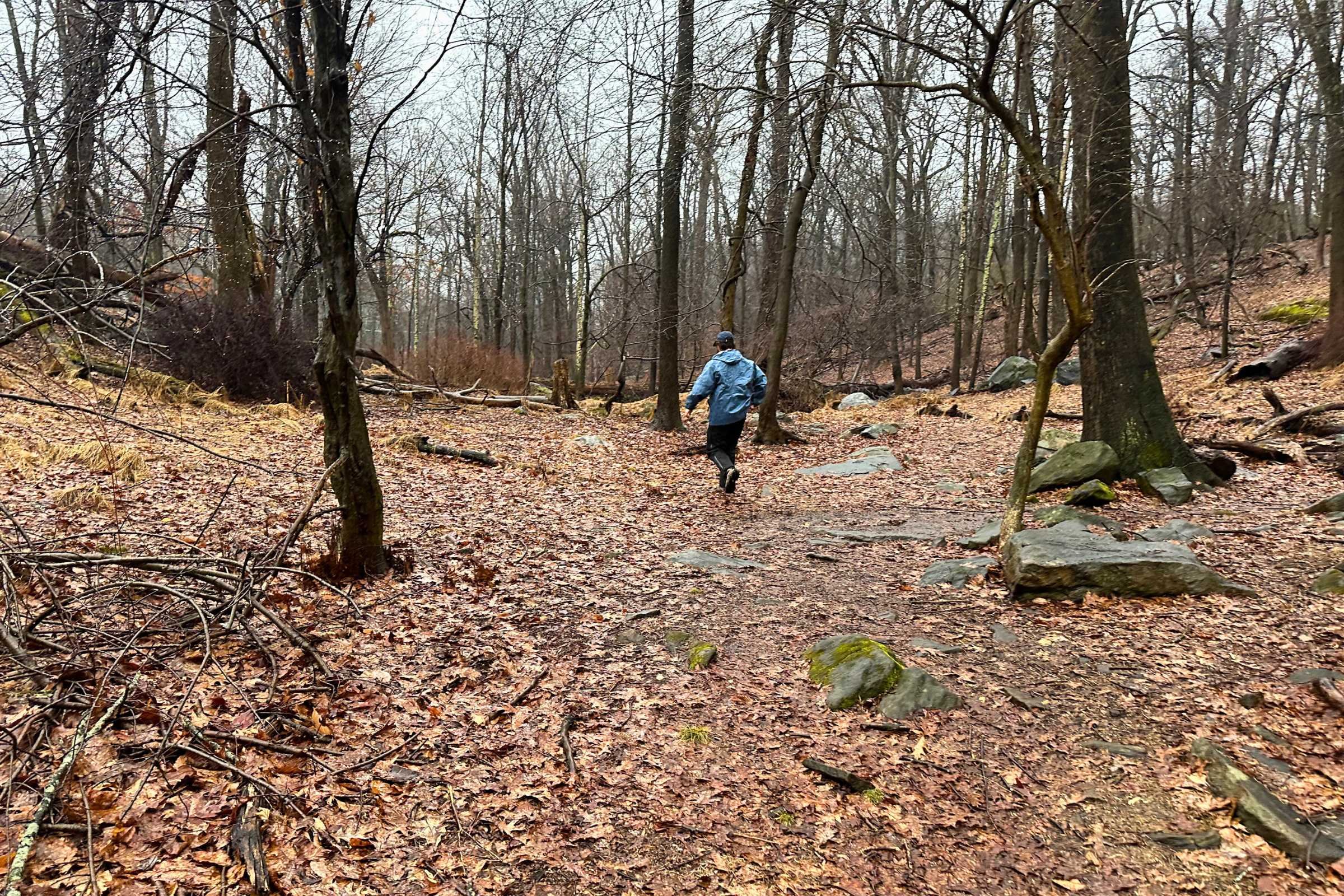
-
The Arc’teryx Beta Rain Pants boast a ton of adaptable and well-designed features, including a built-in belt-adjustable waistband, a zippered fly with a snap, two-way thigh ventilation zippers, a spacious pocket over the front thigh with a storm flap, reinforced instep pads, ankle ventilation zippers, and adjustable ankle cuffs that are effective at keeping water from splashing up into the pants. I know that’s a lot, but it gets better.
-
The waistband is smooth, so it doesn’t dig into the skin over the waistband of your non-rain-pants worn underneath. That said, the fabric is comfortable enough that they could even be worn as standalone pants, and they fit true-to-size. And the built-in belt is so much more comfortable than any drawstring waistband could be. Their cut allows for a full range of movement and is roomy enough for layering over thick insulated denim pants, without leaving excess fabric around the sides that can be tripped over or get caught on branches.
The pocket is advertised as water-resistant rather than waterproof, but did an excellent job at keeping my wallet and phone fully dry in a persistent downpour.
And — partly because of the extended ankle zippers and partly due to the width of their cuffs — the Beta rain pants were exceptionally easy to get on and off without taking off my boots.
A personal favorite feature of mine, their adjustable ankle cuffs make your dreams of jumping in deep puddles without dampening the cuffs of your jeans a reality. Instep reinforcements provide a sense of pants-related safety whether you’re wearing crampons, trying to bushwhack through rough terrain, or stomping through the ice shields of winter water sources.
-
It’s easy to move in the Arc’teryx Beta pants, despite the sturdiness of the fabric. They don’t have the stiffness I feared they might when I first felt the thickness of the fabric.
However, this thick, durable fabric also means that the pants are not very breathable. Thankfully, they have ventilation zippers on the ankles and thighs to mitigate this issue! And mitigate it they do — when wearing these in only slightly cool weather, around 50º to 60ºF, I used both zippers to vent heat and was thankful it worked quite well. Otherwise, the thick material would have felt suffocating.
When I walked through brambles and thorny bushes to get to a good rock to sit on, the fabric didn’t tear, despite being dragged directly into contact with sharp thorns. I would not have trusted any of the other rain pants we tested to withstand the same conditions with the same level of success.
-
The Arc’Teryx Beta Rain Pants would be good for winter hiking, bushwhacking, or general use in areas with abrasive terrain like brambles or rough rocks. After treating some course granite rocks like my own personal slides in these pants, I saw no evidence of the experience on the seat of the pants. However, despite their excellent performance in cooler temperatures, I would not be likely to use them for warm-weather hiking or thru-hiking— they’re bulkier, heavier, and not nearly as breathable as other options.
Even with their impressive ventilation features, the material was too thick for me to use comfortably during intense physical activity. But for walking in unmaintained woods on a cold and rainy winter day, they were everything I wanted them to be.
-
If you’re looking for rain pants that will keep you and your stuff dry in almost any terrain, and resist abrasion while they’re at it, look no further. These pants feel highly durable and they’re built to last years. A family friend told me that she’s been using her Arc’teryx rain pants for almost 7 years and that they’ve held up very well.
While their price tag is quite high, they stand the test of time and can be found on sale. Comfortable, hardy, and highly adaptable, the Arc’teryx Beta AR Rain Pants are clear winners in terms of true durability. Their durable Most Rugged 3L GORE-TEX ePE with C-KNOT backer construction and environmentally friendly waterproofing add to the success of these pants.
Arc’teryx uses their PFAS/PFCS-free FC0 Durable Water Repellent treatment on the Beta Rain Pants– which is both an excellent waterproofing agent and environmentally friendly. For more information about the waterproofing, see the DWR treatment sold by Arc’teryx.
Best rain kilt for hiking: Zpacks VERTICE Rain Kilt
Sizes: N/A
Weight: 2.4 oz
Waterproof fabric: 1.50 oz/sqyd Vertice Waterproof Breathable Fabric
PFAS free waterproofing: No
Face fabric: 7 denier ripstop nylon with tricot backer
What we liked: Super lightweight, adjustable, extremely breathable, comfortable with the zipper
What we didn’t like: Can’t quite do a split in it with the zipper fully down
For any future non-winter thru-hike or longer backpacking trip, I will no doubt be taking the Zpacks Vertice rain kilt. Rain kilts are an appealing option for those who tend to run hot but still want a barrier between themselves and the rain, or for those who want the absolute lightest option above nothing. The Zpacks Vertice Rain Kilt is a truly fantastic option for rainy summer hiking, and it is ridiculously lightweight at 2.4 oz.
View the Zpacks Vertice Rain Kilt
-
The Zpacks Vertice Rain Kilt has a zipper up the side from the hem to the waistband, and the zipper is smooth — not itchy, like the velcro ventilation on the similar ULA Gear Rain Kilt that we tested. Partially unzipping it for more ventilation than the kilt provides inherently is also an option if you want an even breezier rainy hiking experience. This same design can be found in their Dyneema Composite Fabric (DCF) Rain Kilt, which weighs 0.6 oz less.
-
While it doesn’t have a pocket, it’s very easy to access the pockets of your shorts while wearing it.
The loops on the kilt mean it’s easy to attach to a pack with a carabiner when it’s not in use. Like the ULA Gear Rain Kilt, the Zpacks Vertice Rain Kilt packs down very small, though sadly not into its own stuff sack like the ULA does. With the available loops and the drawstring of the waistband, though, it can be tied to stay rolled up, so it doesn’t really need a stuff sack — I just like them.
-
The Zpacks Vertice Rain Kilt is also more comfortable than the ULA Gear Rain Kilt — the lack of velcro along the sides and waistband and different fabric choice provides a less irritating texture. The overall feeling of the fabric is much smoother and not nearly as crinkly.
The Zpacks Vertice rain kilt lays flatter than the ULA rain kilt by far– I almost forgot I was wearing it. I also appreciate that when its waistband hits above the waistband of your shorts, it doesn’t dig into your skin. This is awesome because wearing it above the waistband of your shorts keeps the rain out most effectively, especially if you’re not wearing a rain jacket. When I wore this rain kilt with a rain jacket, the rainwater running down the back of the jacket didn’t touch my shorts at all.
-
Both of the kilts tested are by far the lightest option for rain protection. The clear potential drawback is that they don’t cover all of your legs, but this is a perk to me. I run hot and tend to overheat easily in most rain gear– and often forgo rain gear entirely, especially in summer. But this minimalist and breathable rain kilt is a game changer.
The kilt is made from Vertice fabric with C6 Durable Water Repellent (DWR). Vertice is a three-layer material, similar to what you’d see in more traditional rain gear except much lighter. Similar to other brands, it utilizes a tricot lining to wick moisture away from the skin. In the middle, there’s a waterproof vapor permeable membrane. The outside has a very thin 7 denier ripstop nylon. The total is 1.50 oz/sqyd, which is lighter than most rain gear uses.
If you’re aiming to be AUAP (As Ultralight As Possible) or if you’re just a person who wants rain gear for warm weather but finds that rain pants are just too stifling, this is the rain kilt for you. It’s going to be an integral part of my summer hiking gear going forward — my new best friend on rainy summer hikes.
Other hiking rain pants we tested
Patagonia Torrentshell 3L Rain Pants
Sizes: XS - XXL short, regular (men's), XS - XXL regular, short (women's)
Weight: 11.8 oz (men's), 10.9 (women's)
Waterproof fabric: Waterproof/breathable H2No® Performance Standard 3-layer fabric
PFAS free waterproofing: Yes, made with PFCs/PFAS free DWR coating
Face fabric: 50-denier ECONYL® 100% recycled nylon ripstop face
What we liked: Effective wind and water resistance, great pockets, 2-way ventilation zipper
What we didn’t like: Stiff fabric, excess fabric in lower leg
The Patagonia Torrentshell Rain Jacket is the overall winner in our best lightweight rain jackets guide and we were hopeful for the rain pants. However, we found them less breathable than other rain pants.
The baggy fit of the Patagonia Torrentshell pants made them easy to move around in while walking around. For layering underneath, this was great, and combined with the ankle zippers, these pants were super easy to get on and off over boots. However, we found them less breathable than other rain pants.
Compare prices of the Patagonia Torrentshell 3L Rain Pants
Men's
Women's
A cool feature of the Patagonia Torrentshell rain pants is their long, two-way ventilation zipper. This lets you customize the breeze to both your upper and lower leg.
The thick fabric is stiff, which affects ease of movement and is not breathable unless the ventilation zippers are fully utilized. They still pack down relatively small even with their thicker construction, which surprised me, but they’re far from the lightest or smallest option.
Also, their overall lack of breathability meant that they took a while to dry after sustained rain, and only mild perspiration resulted in a good amount of moisture buildup inside, which was unpleasant.
One cool thing about these pants is that Patagonia uses a PFCs/PFAS-free membrane in their rain gear, and the Torrentshells are no exception– so if you’re looking specifically for a PFCs/PFAS-free option, these fit that bill. It's also made in a Fair Trade Sewn factory and comes with Patagonia's Ironclad Guarantee and Repairs.
Ultimately, these pants were good and could be used for colder weather hiking, camping, or commuting. But their crinkly texture, heft, and lack of breathability make them less ideal for backpacking or warmer weather pursuits.
REI Co-op Trailmade Rain Pants
Sizes: S Short - XXL Tall (men's), XS - 3X (women's)
Weight: 7.8 oz (men's), 13.1 oz (women's)
Waterproof fabric: 2L waterproof/breathable fabric
PFAS free waterproofing: Yes
Face fabric: Ripstop nylon
What we liked: Adjustable waistband, ankle ventilation zippers, breathable
What we didn’t like: Clammy, slim cut inhibits movement
The REI Co-op Trailmade Rain Pants are the pants I used on my Appalachian Trail thru-hike. My verdict on them is that they are a decent and affordable option, but there are better ones out there at the same price. The Marmot PreCips, for example, are a better value.
The REI Trailmade rain pants have breathable fabric, a spacious back zipper pocket, a packable design, and adequate zippered ankle ventilation. They are by no means a bad choice. It’s just that the Marmot PreCips outperformed them in so many aspects. The Trailimades lack adjustable ankle cuffs and side zippered pockets, and are cut in a way that inhibits ease of movement unlike the PreCips.
View the REI Co-op Trailmade Rain Pants
Men's
Women's
The cut of the Trailmade pants is slim enough for them to pass as regular pants, which I liked– but it is a bit harder to layer with them as a result.
The REI Trailmade pants have just one back pocket in comparison to the Marmot’s two side pockets and back pocket. In addition, I found that the Trailmade pants became clammier faster than the Marmots after being worn in similar conditions.
REI is in the process of transitioning away from the use of PFCs and PFAS in their products.
Furthermore, the slimmer cut of the Trailmade pants is sleeker– but at the cost of flexibility, range of motion, and ease of layering underneath. Even while on the Appalachian Trail with the REI Trailmade pants, I was envious of hiking buddies with looser-fitting pants because they looked so much easier to move in. I still like the Trailmades for hiking or for a stroll to the mini-mart in a thunderstorm, but the Marmots are unquestionably a better choice for the same purpose.
Weight: 2.8 oz
Waterproof fabric: Silicone impregnated nylon
PFAS free waterproofing: Yes, made from 100% nylon
Face fabric: Silicone impregnated nylon
What we liked: Packs down small into an integrated stuff sack that velcros shut, comes in many color options
What we didn’t like: Itchy velcro, feels very crinkly, like wearing a plastic bag
The ULA Gear rain kilt was the first rain kilt I ever put on, and it is extremely lightweight. The inherent ventilation of a rain kilt is unmatched. However, this one was not my first choice after testing it alongside the Zpacks Ultralight Rain Kilt, for a couple of reasons.
View the ULA Gear Rain Kilt
This photo is totally not blurry– it’s just that I’m more aerodynamic in a kilt.
The waistband is adjustable with velcro, as is the ventilation of the side. However, the velcro is quite uncomfortable and digs into the skin. The fabric itself crinkles excessively, and with movement, this became annoying. Its crinkling is reminiscent of a piece of plastic, like a non-stretchy garbage bag or lightweight tarp, which is not especially comfortable to wear.
This rain kilt has some cool features. My favorite is that it packs down into its integrated stuff sack, which velcros closed, and has a little loop for easy attachment to a pack via a carabiner. But the velcro and crinkly fabric greatly detract from the wearing experience.
The Zpacks rain kilt has a zipper that goes up the side and smoother, softer-feeling fabric, in addition to being lighter than this one. But if a true, fully-containing stuff sack is essential for you — and the texture of the fabric isn’t a dealbreaker — the ULA rain kilt will work.
Alternatively, if you’re just looking for an ultralight rain kilt that’s more affordable than the Zpacks one– the ULA rain kilt is still potentially a better option than rain pants. And, as with the Zpacks rain kilt, the lightweight nylon construction means there are no PFCs or PFAS in the product.
Decathlon/Quechua MH500 Waterproof Hiking Overpants
Sizes: W28 L33 - W44 L 34 (men's), W24 L 30 - W38 L 31 (women's)
Weight: 9.5 oz (men's), 5.8 oz (women's)
Waterproof fabric: 3-layer membrane, 15,000 mm H2O mm (Schmerbers)
PFAS free waterproofing: No, however it uses a water repellent treatment without perfluorocarbons.
Face fabric: 100% Polyester
What we liked: Adequate ankle ventilation zippers, packs down easily into large waterproof pocket
What we didn’t like: Difficult to move around in, surprisingly hard to get on and off over boots
The Decathalon/Quechua MH500 Waterproof Hiking Overpants fit true to size but have a restrictive cut that is slim in the thighs and loose in the calves. This may make them look a little bit sleeker, but being a member of the Thunder Thighs community, this was a problem.
View the Decathlon/Quechua MH500 Waterproof Hiking Overpants
Men's
Women's
Even though their ventilation zipper is quite long, it’s difficult– still possible, but difficult– to get these on over boots without taking the boots off.
They have almost no give — when off the path and walking with longer strides over rocks and roots, the tightness in the thighs caused the non-flexible fabric to pinch annoyingly. This wasn’t as much of an issue when walking slowly on a well-maintained path, but any stride longer than a shuffle made moving in these pants uncomfortable. Surprisingly, even with sufficient ankle ventilation zippers, these pants proved difficult to get on without removing my boots as the boots got caught in the thighs of the pants. Wearers of trail runners or tennis shoes might not have as much difficulty, but it still requires more footwork than none to get these on over shoes which is not ideal.
These pants have a large, internal pocket. While the pocket has more than enough room for anything you’d possibly need to carry on your person, being completely internal means it is not possible to access without reaching fully into your pants. I did not appreciate that, nor did I enjoy the feeling of my phone and wallet bouncing against my leg due to the pocket not being sewn into the leg itself. However, the pocket protected its contents adequately when exposed to sustained precipitation in the shower. The pants pack into this pocket for storage but are still quite bulky when packed down.
The Decathlon/Quechua MH500 Waterproof Hiking Overpants are not noticeably breathable, and customer reviewers seem to agree. For me, this resulted in relatively quick moisture accumulation inside the pants, even just walking briskly in relatively cool weather. Also, the waterproofing is noted to be inconsistent. Some reviewers say it’s great, others say the pockets leak and the pants wet out quickly. On my pants, the lower halves wet out within minutes while the thighs shed water effectively for almost an hour in the shower.
Decathlon is another company that is moving away from use of PFCs and PFAS in their products– see their statement on sustainability here.
Sizes: Small short to XXL Tall
Weight: 11.2 oz
Fabric: 100% Polypropylene
PFCs/PFAS-free waterproofing: Yes, 100% Polypropylene
What we liked: Cheap!
What we didn’t like: Everything else…
I wanted so, so, so badly to like the Frogg Togg rain pants since I am a staunch advocate of their most affordable rain jacket (see my glowing review of it in my article on my AT favorite gear). However, I loathed these pants from the moment I put them on and no amount of practiced open-mindedness could make me like them.
View the Frogg Toggs Ultra Lite 2 Rain Pants
Billowy, so billowy… This does not do justice to the sheer amount of fabric.
Note: You can only purchase them as a set with the rain jacket
Not only are the proportions peculiar and uncomfortable, they are comically oversized to the point that the excess fabric presents a genuine hazard. This could be remedied somewhat by features such as adjustable ankle cuffs or an adjustable waistband, but alas, these pants have neither.
The non-adjustable elastic waistband is itchy, and the non-adjustable ankle cuffs aren’t elastic. Also, they do not have a single pocket, which is unfortunate. They did come with an unattached stuff sack that buttons closed and has little loops, which is nice. However, the scratchy feeling of the interior fabric of these pants against the skin of my legs when I wore them with shorts was sensory hell and made my skin crawl. Wearing them with long pants somewhat improved that aspect of the experience, but it was still reminiscent of wearing a whole tarp.
To be honest, I felt like a clown in a big garbage bag suit in these pants. I’m going to keep them in my car in case I’m at an outdoor event and it starts pouring. In sum, I cannot recommend them as hiking rain pants, but they could potentially be good to have around in a pinch– and I still think their counterpart rain jacket is stellar. And, they’re PFCs and PFAS-free!
The REI Trailmade rain pants and I headed down the road in a torrential downpour in Uruguay.
Why do you need hiking rain pants?
Protection from the elements
Rain pants will protect you from the elements, like rain, wind, snow, and mud. Sudden downpours on a day hike, a stretch of rainy weather during a backpacking trip, or gusty winds on a ridge can catch anyone off guard. Rain pants keep you dry, help you stay warm, and shield you from the wind so you can enjoy being outside in inclement weather.
Maintaining comfort
Wet clothes suck to wear. They’re uncomfortable, they sap heat from your body, and over a prolonged period can even contribute to hypothermia or chafing. By wearing rain pants when you’re outside in the rain, you can focus on enjoying the outdoors rather than lamenting wet, soggy clothes and cursing the clouds.
The Outdoor Research Foray pants are comfortable and keep water out on the path and on the trail.
Breathability and moisture management
Of course, it’s not all about keeping rain out. You’re going to want your rain pants to be breathable so it doesn’t feel like you’re marinating in sweat and grime underneath them. When rain pants aren’t breathable enough, the result is clamminess, which not only feels unpleasant but leads to a buildup of moisture inside the pants, which is the opposite of the point of wearing rain pants in the first place.
Breathable waterproof fabrics, such as recycled ripstop nylon, and design features such as ventilation zippers allow sweat vapor to escape while still preventing rain from entering, keeping you dry for longer.
Breathability is especially important if you’re a person who runs hot or if you're hiking in warmer temperatures or humid climates. Wearing non-breathable rain pants during physical activity makes one feel like a dumpling steaming inside a garbage bag, and then a cold, clammy dumpling that is not particularly enjoying itself.
Overheating in warm adverse weather conditions —such as heavy rains and strong winds during a summer thunderstorm — is also a possibility, so breathable rain gear is essential.
Exploring the local woods in winter in New York in the Arc’teryx Beta AR rain pants.
Versatility in changing weather conditions
Unless you’re setting out specifically to hike in the rain, you probably won’t usually be wearing your rain pants. It’s still a good idea to have them, though, because you’ll have a gear setup that is more versatile and you’ll be prepared for changing weather conditions as a result.
Weather predictions on the ground aren’t an accurate indication of the weather in the mountains. Sometimes you’ll encounter weather you weren’t expecting, like sudden wind and showers at high elevations. Carrying packable rain pants that will protect you from the elements. And when the rain and wind catch you off guard, rain pants that are easy to get on and off let you react faster and stay drier in a changing environment– keeping you prepared for a wider breadth of weather scenarios.
The Marmot PreCip Eco pants are dog-approved– and withstood her claws as she jumped on me with pure joy.
Protection from mud and wet terrain
Rain pants aren't only for keeping rain out — they can also shield you from mud, puddles, generally wet terrain– and even bugs! Muddy trails and soggy fields threaten to soak the hems of your pants. Rain pants are a barrier that can keep your legs and pants protected from splattering mud or puddles. Not only can this make your experience in the outdoors more comfortable in wetter terrain, but it can help protect your clothing and footwear as well.
Preventing hypothermia
In wet, damp, or chilly conditions, soaked clothing is a risk factor for hypothermia.
Rain gear helps to prevent heat loss in these conditions by blocking outside moisture and allowing you to retain body heat, thus reducing the risk of hypothermia. Breathable rain gear is important here as well, as moisture buildup from sweat vapor can soak your clothing too.
Even if it isn’t raining, many hikers wear their rain gear over dry gear to trap body heat and keep them warm during cooler conditions.
Protecting your insulating layers
Your insulating layers are essential for staying warm– but they lose their effectiveness when damp. Rain gear can be a helpful tool for preserving the effectiveness of insulating layers, keeping them dry so that their thermal properties help you stay warm.
Even if it’s not raining, rain gear can be worn over dry insulating layers to help retain body heat. On the Appalachian Trail in November and December, I wore my dry rain gear to sleep on especially cold nights. Dry rain gear paired with a dry set of sleep clothes is an incredible way to sleep warmly and comfortably.
Jumping for joy in the Outdoor Research Helium rain pants!
Extended comfort in persistent rain
In persistent rain, rain pants are just generally nice to have because they keep your pants from getting drenched. On days when the rain just won’t stop, you’ll find that they’re well worth their weight. Prolonged periods of rain (like the multiple days of rain I experienced on the Appalachian Trail) mean that when your clothes get soaked, they stay soaked. Having rain gear can stop them from reaching that point so you won’t have to start your day wet.
Flexible enough to do whatever this is. Dog approved.
What to look for in hiking rain pants
Fit and Comfort
Fit and comfort are just as important as waterproofing. If your rain pants don’t fit well or are uncomfortable, you’ll dread putting them on and they’ll be more of a hassle than a convenient tool. Further, poor-fitting, overly tight, or not-ideally-constructed rain gear can hinder movement, making wearing them more trouble than they’re worth.
Waterproofing Technology
The waterproofing technology of rain gear, such Gore-Tex or breathable nylon, will influence how it protects against rain and moisture, as well as its degree of breathability.
The effectiveness of waterproofing technology plays a large part in whether you stay dry during outdoor activities. Keep in mind that more rugged waterproofing hinders breathability, so it is better suited for lower-intensity or lower-temperature activities such as camping, winter hikes, or fishing. For a thru-hike, a longer backpacking trip, or higher intensity hiking, lighter-weight and more breathable waterproofing material would be ideal.
For more information about levels of waterproofing, we dig into waterproofing specifics in our Best Lightweight Rain Jackets guide. And for more information on why some brands are switching to PFAS-free waterproofing and DWR treatments, check out our full guide.
Breathability
Breathable rain gear facilitates airflow while keeping the barrier against rain, which can help you stay dry during physical activity in damp or rainy conditions. This allows sweat vapor to evaporate rather than accumulate as condensation and is essential for warmer weather or intense physical activities.
Especially if you run hot, non-breathable waterproof fabric in these conditions will make you overheat and cause clamminess inside your rain pants, which can not only cause you to become cold once you stop moving but also feel gross.
Asking the sky for more rain in the Zpacks rain kilt. Just for fun.
Ease of On/Off
Some features of rain pants, such as two-way ankle zippers, make them easier to take on and off. This may not seem like a huge deal, but while testing rain pants, I spent a lot of time tripping over myself and kicking like a bug stuck on its back trying to get rain pants on and off in muddy trailhead parking lots. If you can put on or take off your rain pants easily and quickly without having to take your shoes off or getting into a tangled mess of Gore-Tex and puddle water, it’s a major perk.
Durability and Construction
REI XeroDry, on the rocks…
Durability in rain gear is important for ensuring that rain pants can withstand outdoor conditions over time. Well-constructed rain pants made with quality materials can resist damage such as abrasion, punctures, and exposure to the elements. Longevity and reliability minimize the need for frequent replacements, which minimizes gear ending up in landfills and can save you money in the long run. You also won’t have to worry as much about gear failures such as creases, rips, or tears forming in the fabric.
Weight and Packability
Lightweight and packable rain pants are convenient for travel and essential for outdoor pursuits where space and weight need to remain optimized, like a thru-hike. Compact and lightweight rain pants are easy to carry and tuck away in your backpack or luggage.
Packability is always convenient. For most uses, being ultralight is just not necessary. For a thru-hike, I’d take one of the lighter options for pants or a rain kilt, but for day hikes or short backpacking trips, a relatively heavy but more comfortable and durable pair would be my choice.
Versatility
In whatever outdoor pursuits you embark on, adjustable and versatile rain pants are a useful gear item to have– game-changers for any outdoor activity, whether you're hiking, biking, or just out exploring.
Rain gear with versatile, adaptable features like zippers and pockets, adjustable waistbands and cuffs, and breathable, lightweight fabric can keep you and your things dry and comfortable in a range of weather conditions.
No matter what the weather does, rain pants with versatile and adjustable features can be tweaked to keep you comfortable and dry. Rain pants that are versatile overall and have these helpful features built in let you adapt your gear to specific situations on the spot– and help you stay prepared for those situations to change.
Ventilation Zippers
Ventilation zippers are an especially adaptable feature, increasing breathability and helping with temperature regulation during physical activity.
The customized airflow allowed by zippered vents is particularly useful in warmer climates. Two-way zipper design lets you customize your rain pants' breathability and makes them way easier to get on and off.
Almost all of the models we tested had something in the way of ventilating zippers, and the Arc’teryx Beta AR Rain Pants had the most adaptable ones
Cuff Design
The tight cut of these pants’ upper leg meant that stepping up onto this log from the ground made them pull uncomfortably.
Adjustable cuffs are a useful feature for keeping water from splashing up into your pants through the ankles. The ability to adjust the fit of the cuffs of your rain pants over your dry pants lets you jump in puddles to your heart’s content, without having to worry about soaked hems after. As jumping into puddles is a major part of my testing process, I learned the perks of adjustable or well-sealing elastic cuffs quickly.
However, many rain pants do not have this feature. Some, such as those with elastic but non-adjustable cuffs, are still effective at keeping water from splashing upwards into the pants. Others have neither elastic nor adjustable cuffs and allow water to soak through to the cuffs of your fair-weather pants.
Cuff design also impacts how your rain pants will interact with your footwear. Boots, sneakers, and trail runners all hit different points on the ankle and lower leg. So, depending on the fit and design of your shoes, it’s important to consider where the cuffs of your rain pants will hit, and how they will cooperate with your footwear and/or gaiters.
Pockets
It’s got side pockets with zippers! We– people who regularly drop things– love that!
It’s always nice to have pockets, and the pockets of rain gear must keep their contents dry. Pockets add functionality and an element of convenience to rain gear. When you can store small essentials such as phones, wallets, and keys in pockets of your rain pants, they’ll always be close on hand and you won’t have to take off your rain pants to access the pockets of your fair-weather pants underneath.
With rain gear, having pockets that can keep water out and help protect your essential items is important. Zippered pockets with storm flaps over the zippers keep things secure and protect them from the rain, which lets you keep them on hand — and dry — in any weather. In my experience, cashiers in trail towns are generally understanding when handed a pile of wet cash, but if I’d had rain pants with good waterproof pockets there would have been no wet cash to begin with.
Warmth
When looking at rain gear, consider how cold the conditions will be and how much warmth you want the rain pants to provide. Thicker and more durable rain pants will perform best in colder conditions, such as freezing rain or snow during winter backpacking. Ultralight and thinner, more breathable rain pants will perform best in warmer conditions, such as summer rainstorms on a thru-hike. Knowing the range of temperatures you’re expecting to encounter can inform your decision.
Reflective Elements
Reflective elements such as logos, stripes, or other markings enhance your safety in low-to-no-light conditions and nighttime activities.
In the rain, whether day or night, visibility is even more limited than usual. Rain gear with reflective elements can keep you visible in rainy conditions, whether you’re crossing a road or at camp.
Unfortunately, most of the rain pants we tested didn’t have much in the way of reflective logos. That’s generally fine for hiking, but if you’re running, see our guide to best reflective running gear for reflective accessories that can improve your visibility.
Sustainable Material and PFAS and PFC-free
It’s good at repelling water, but the ULA rain kilt feels as crinkly as it looks. It's made of a PFAS/PFC-free silnylon material.
While the manufacturing of rain gear, in general, can be harsh on the environment, some do better than others.
Seek out brands that share their supplier information with consumers, including the specifics of how and where their gear is made.
Look for indications of bluesign® approved fabric, which is considered the highest standard in the industry to use methods and materials that minimize the impact on people and the environment. Bluesign works “at each step in the textile supply chain to approve chemicals, processes, materials, and products that are safe for the environment, safe for workers and safe for the end customers.”
Increasingly important in rain gear, look for items without intentionally-added perfluorinated chemicals (PFCs/PFAS) — including the durable water repellent (DWR) finish. PFCs/PFAS are persistent chemicals (sometimes called "forever chemicals") so we find them even in our water. That's why technically, it's impossible to be PFAS-free, we look for brands that aren't intentionally adding these chemicals to their waterproofing. We note where brands are working on removing PFAS and use the shorthand "PFAS-free" to indicate where there are no PFAS or PFCs.
How to choose the best hiking rain pants for you
Where are you going to be?
It rains just about everywhere, but different regions have varying climates and rainfall frequency, intensity, and duration, as well as wind and temperature fluctuations. Keep your location in mind when you’re looking for rain pants to determine the level of waterproofing and breathability you’ll need for the weather you expect.
Knowing the general temperature range and degree of fluctuation of where you’ll be is relevant to the selection of rain gear. Certain materials or designs — such as lightweight, breathable fabric, or a rain kilt instead of pants — will be better suited for hotter climates where you’ll want to prevent overheating. In colder climates, you’ll want thicker material to retain body heat and a looser fit that allows for layering underneath the pants.
What are you planning to use them for?
How you intend to use rain pants is another factor to consider when selecting which ones are right for you. For activities like backpacking, having lightweight and breathable rain pants will be essential. For more stationary activities, such as fishing or camping, durability and waterproofing will be your main concerns.
It’s also important to remember that your rain gear will likely be packed away much of the time you’re out, so pants that are packable are generally ideal.
What’s your budget?
As always, budget is a significant aspect of outdoor gear selection. But don’t worry — while high-end rain pants may offer some advanced features, there are a variety of quality, budget-friendlier options available that provide sufficient protection. That said, while certain models cost more, if they are higher quality they will not need to be replaced as frequently. They may be a worthwhile investment in the long run if you plan on getting a lot of use from your rain pants.
Hiking rain pants care and maintenance tips
Taking good care of your pants overall will help to keep them in good condition. Checking for signs of wear and damage periodically —– and paying attention to how your rain pants should be cleaned and dried —– will let you make good use of your gear for as long as is physically possible.
Washing
Follow the manufacturer’s cleaning instructions. Read the label. Most rain pants can be machine-washed with a gentle detergent, but check anyway. Generally, unnecessary or harsh products like fabric softeners or bleach should be avoided as they can compromise the waterproofing, breathability, and integrity of the fabric or its water-repellent coating. Some laundry detergent strips the waterproofing right off. We recommend washing with a product specifically designed for waterproof technical fabrics, like NikWax or Grangers. See our guide to How to Wash a Gore-Tex for more information.
Drying
It is tempting to throw rain gear in the dryer on a regular setting if you’re pressed for time, but high temperatures and even direct sunlight can compromise the effectiveness of the water-resistant materials rain gear is constructed from. It’s not fun having to replace rain gear because it absorbs water instead of repelling it. If the label says you can use a dryer, use the lowest possible heat setting and remove them promptly to avoid overheating.
Air-dry your rain pants whenever possible, and make sure they dry out completely so they don’t turn into a wearable petri dish!
Storage
Once they’re fully dry and you’re not using them, rain pants should be stored in a cool, dry place away from both direct sunlight and moisture. Hanging, rolling, or folding them loosely helps to avoid creases through which water can leak in and to maintain their shape.
Waterproof Treatment
If your rain pants have been treated with a DWR (Durable Water Repellent) coating, it may eventually wear off and your pants will begin to absorb water. You can restore their water repellency by re-proofing with a DWR treatment. Follow the instructions of the manufacturer if you choose to use a spray-on or wash-in DWR product for the best results in restoring the waterproofing of your gear.
With use and wear over time, some tears, punctures, and damage to your rain pants will inevitably occur. It’s a good idea to repair them ASAP to prevent further deterioration or damage, as a small tear is only one snag away from becoming a gaping hole. Repair tape, seam sealer, or simple sewing can mend most rips your rain gear will acquire.
Check out our guide on How to Clean and Repair Gore-Tex and Other Shells to learn more.
Avoid Abrasion
To avoid causing damage to your gear, be mindful of interactions with abrasive surfaces such as rough rocks, sharp branches, or thorny brush. It’s impossible to avoid all damage, but avoiding dragging rain gear through especially abrasive surfaces can prevent a good amount of it. I have learned that most rain pants don’t like sliding down coarse rocks. Keep this in mind.
FAQ
-
All hiking rain pants are constructed to be waterproof, but the degree of waterproofing will vary depending on the construction. Rain pants are constructed from materials like Gore-Tex or lightweight nylon, which keep them generally waterproof. While all gear will wet out eventually if the rainfall lasts long enough or comes in great enough volume, rain pants made from materials like Gore-Tex will take longer to wet out than thinner waterproof fabrics like lightweight nylon.
-
Some rain pants are more breathable than others, depending on the materials they’re constructed from, their design– such as roomier fits that allow more air in, or kilts– and additional features like ventilation zippers.
Specifically breathable, lightweight hiking rain pants are designed to allow moisture vapor from sweat to escape while still keeping the rain out. They are ideal for high-intensity physical activities, and warmer or humid conditions where a lot of sweat will be generated.
-
Hiking rain pants can be worn in warm weather, but breathable ones with good ventilation features are essential if you don’t want to overheat. Heavier rain pants will feel stifling in warm weather. They’ll also lead to a buildup of sweat inside the pants, which is gross.
For warm weather rain gear, look for rain pants made from lightweight, breathable materials, and consider wearing moisture-wicking base layers to help regulate temperature and minimize sweat buildup. Or, consider wearing a rain kilt over shorts!
-
Hiking rain pants can most definitely be worn over regular pants — it’s the common practice since you’re not likely to set out already wearing rain pants. And since many rain pants have waistbands that are itchy on their own it just makes sense to wear pants underneath. Layering also provides added insulation and helps with temperature regulation and managing moisture.
-
Hiking rain pants can be awesome for snow or winter conditions, but additional layering or a heavier, more durable construction will likely be necessary for adequate warmth and insulation. For example, of the hiking pants we tested, the Arc’teryx Beta Rain Pants would work best for winter conditions.
Many rain pants are great at blocking wind as well as repelling moisture, which is a huge asset in snow or winter conditions where cold, wet wind will feel brutal. Layering rain pants over thermal base layers or insulated pants can keep you comfortable in cold environments and allow you to winter hike and backpack cozily.
-
Absolutely — most tears and damage to hiking rain pants can be repaired relatively simply. Small tears can be patched with repair tape or sewing, while seam sealing can address tears or damage to seams. More extensive damage may require a combination of sewing, taping, or seam sealing to ensure durability and waterproofing. For more information on repairing tears or damage to rain gear, see our guide on How to Clean and Repair Gore-Tex and Other Shells.
-
You can technically wear hiking rain pants as standalone pants, but it’s usually not very comfortable since they tend to feel clammy and unpleasant on bare skin. They could possibly be worn as standalone pants in milder weather or for low-intensity activities if you don’t sweat much or don’t mind the sensation of waterproof material on your skin. But honestly, I wouldn’t. It’s much more comfortable to wear them over other clothing to avoid general clamminess, or itchy waistbands and cuffs. Wearing hiking rain pants with base layers or moisture-wicking clothing helps with temperature regulation as well as overall comfort.
-
Absolutely! Hiking rain pants are versatile outdoor garments suitable for many activities beyond hiking, including backpacking, camping, trail running, fishing, outdoor work, commuting, or even just walking the dog. The protection from rain, wind, and moisture offered by rain pants is ideal in diverse environments– not just while hiking.
How we researched and tested
The rain pants featured in this review and I have spent a lot of time together this year. They were worn in varying degrees of rain in summer temperatures in Uruguay. They stomped in the countless chilly puddles of winter rain on New York ridgelines. One was carried through freezing rain and high winds on the Appalachian Trail during the winter of 2023 and more on a thru-hike of the Colorado Trail.
We collected kindling, searched for cool rocks in the woods, and went on adventures, like day hikes with the dog, and trips to the mini-mart. I slept in them in sub-zero temperatures in the Great Smoky Mountains, wore them on a semi-successful expedition to gain the trust of a stray dog, and even in the shower to see how they held up in constant downpour.
About the author / Why you should trust us
Elliot Koeppel is a recent graduate of Tufts University with a B.A. in History. After six months on trail, he finished his awesome, if rather rainy, thru-hike of the Appalachian Trail in December 2023. In his free time, he can be found looking for rocks, making jewelry, listening to Van Halen, and seeking out the sickest birds known to man.
To see all of Elliot's stories, check his author page.

